A Finnish Touch
150 years of Finnish landscapes

Leading by Example
Nordic innovation, global reach
Artistic Inheritance
Emil and Dines Carlsen
M(other) Tongues
Weaving family and art
The Magazine of the National Nordic Museum
NORDIC KULTUR 2021–22
See what’s in store…
Nordic housewares, artisan jewelry, small-batch candies, best-selling books, Scandinavian toys, and more in the Museum Store
nordicmuseum.org/museumstore



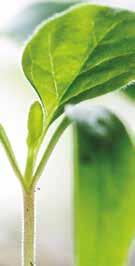

CONTENTS 3 FROM THE CEO 4 EXHIBITIONS 2021–22 An overview of art 6 AMONG FORESTS AND LAKES Finnish National Gallery Masterpieces 11 A ROYAL WEAVING New tapestry acquisition 12 M(OTHER) TONGUES Three generations making art together 16 PAPER DIALOGUES A papercut conversation 18 A PANDEMIC PRESERVED Oral history in the time of COVID 22 IN THE CARLSENS’ STUDIO A father/son artist duo 26 LEADING BY EXAMPLE Why the world needs Nordic innovation 29 VOLUNTEER SPOTLIGHT Q & A times three 30 DRESSING A NATION The Nasjonaldrakt 35 A STITCHED SAGA A crowd-sourced embroidery project 36 NORDIC AMERICA National Nordic hotspots 38 SAVING FOR THE FUTURE Norway’s seed vault 41 SCAN DESIGN An important partnership 42 A TOUCH OF NATURE Friluftsliv and you 44 WEAR IT AGAIN, SAM Creating a closed-loop fashion industry 46 SILVER SCREEN, GOLDEN GOAL A Nordic commitment to equality in film 48 HERE COMES THE BRÚÐR Nordic wedding traditions 51 A BIG DILL Host your own crayfish feast 54 HIP HIP HOORAY Happy birthday, Moomin and Pippi 58 BEER SOUP A new twist on a classic
Join the National Nordic Museum— become a Member today.
Free Museum admission, early access to event tickets, discounted program prices, savings in the Museum Store, and more.
nordicmuseum.org/membership
NORDIC KULTUR 2021–22
The Magazine of the National Nordic Museum
EDITORIAL BOARD AND MAGAZINE STAFF
Eric Nelson Executive Director/CEO
Leslie Anne Anderson Director of Collections, Exhibitions, and Programs
Jenny Iverson Development Manager
Erik Pihl Director of Development
Rosemary Jones Publisher / Director of Marketing
Devon Kelley Editor / Marketing Manager
Ani Rucki Design and Layout / Graphic Designer
CONTRIBUTORS
Leslie Anne Anderson | Rachel Ballister | Stina Cowan | Alison DeRiemer | Judith H. Dern
Kate Dugdale | Becky Forsberg | Lotta Gavel Adams, PhD | Carrie Hertz, PhD | Jenny Iverson | Rosemary Jones
Devon Kelley | Timothy Krumland | Caroline Parry | Erik Pihl | Robert Strand, PhD
BOARD OF TRUSTEES
Trustees
Thomas Malone (President) | Hans Aarhus (Vice President) | Earl Ecklund (Treasurer) | Monica Langfeldt (Secretary)
Electa Johnson Anderson | Lars Anderson | Anne-Lise Berger | Jann Blackbourn | Ray Brandstrom | Jay L. Bruns, III
Ulf Edwaldsson | Ann-Charlotte Gavel Adams | Mike Hlastala | Tapio Holma | Jane Klausen | Kurt Manchester
Jens Molback | Kurt Ness | Per Norén | Aaron Overland | Tuula Rytilä | Maria Jones Staaf | Birger Steen
Henrik Strabo | Johan Erik Strand | Heli Suokko | Nina Svino Svasand | Lisa Toftemark
Consuls
Mark T. Schleck, Honorary Consul, Denmark
Matti Suokko, Honorary Consul, Finland | Kristiina Hiukka, Honorary Vice Consul, Finland
Geir Jonsson, Honorary Consul, Iceland
Viggo Forde, Honorary Consul, Norway
Petra Hilleberg, Honorary Consul, Sweden
Honorary Trustees
Senator Reuven Carlyle | Leif Eie | Irma Goertzen | Senator Mary Margaret Haugen
Lars Jonsson | Sven Kalve | Council Member Jeanne Kohl-Welles | Senator Marko Liias
Fidelma McGinn | Representative Gael Tarleton
MUSEUM STAFF
Executive
Eric Nelson Executive Director/CEO
Sandra Nestorovic Chief of Staff
Curatorial
Leslie Anne Anderson Director of Collections, Exhibitions, and Programs
Stina Cowan Educational and Cultural Programs Manager
Alison DeRiemer Archivist and Oral History Specialist
Kate Dugdale Education and Interpretation Coordinator
Pete Fleming Exhibition Designer and Preparator
Kaia Wahmanholm Registrar and Collections Specialist
Development
Erik Pihl Director of Development
Jenny Iverson Development Manager
Rachel Ballister Membership and Database Coordinator
Caroline Parry Grants and Giving Coordinator
William Ekstrom Development Events Coordinator
Marketing & Communications
Rosemary Jones Director of Marketing
Devon Kelley Marketing Manager
Finance & Human Resources
Pamela Brooks Director of Finance and Human Resources
Carolyn Carlstrom Bookkeeper Drue Chatfield Human Resources Generalist
Timothy Krumland Volunteer Coordinator
Operations
Adam Lee Allan-Spencer Director of Operations and Facilities
Donna Antonucci Guest Services and Event Associate
Roberta Chen Guest Services and Store Associate
Becky Forsberg Guest Services Manager
Joni Hughes Store and Purchasing Manager
David Leers Facilities Coordinator
NATIONAL NORDIC MUSEUM 2655 NW MARKET STREET, SEATTLE, WA 98107 | 206.789.5707 | NORDICMUSEUM.ORG
Welcome to Nordic Kultur, the magazine of the National Nordic Museum!


Like many cultural attractions, the Museum faced a challenging year in 2020. Our doors were closed to the public for nearly eight months; we were unable to welcome visitors to the Museum to view our exhibitions or participate in our programs, special events, and festivals. Those quiet hallways and empty galleries spurred us to find new ways to engage with you and steered us to a year of experimentation and innovation. We shifted our programming to a virtual format to share content, highlighting national and international artists, noteworthy academics, and global thought leaders to explore a host of compelling subjects. The new virtual approach enabled us to build an international online community, dramatically expanding our reach.

As we look to 2021 and beyond, I am pleased to welcome you back to our galleries to enjoy incredible new exhibitions. In May, we host Among Forests and Lakes: Landscape Masterpieces from the Finnish National Gallery which examines how Finnish artists have depicted the landscape of their native country from the 1850s until the present day. Curated by the Finnish National Gallery, the exhibition explores the sophistication of the Finnish art establishment and the concurrent development of the landscape genre through more than fifty paintings, prints, and video art. Additional 2021 exhibitions explore the history of Nordic ski jumping in the Pacific Northwest, a cross-cultural papercut dialogue,
the multi-generational work of a very artistic Dominican-Norwegian family, and the works of Danish-American artist Dines Carlsen.

Also featured in this issue are articles about our recent acquisition of a royal Swedish tapestry, our new pandemicrelated oral history initiative, a piece on Nordic innovation by Dr. Robert Strand, as well as ruminations on the new Nordic “it” word, friluftsliv. Additionally, UW professor Ann-Charlotte Gavel Adams shares perspectives on Nordic children’s icons, and our own Stina Cowan talks about Nordic cinema. All of these and more articles await you in this issue of Nordic Kultur. I hope you enjoy these stories and articles, and that they inspire you to come visit your Museum.
Eric Nelson Executive Director/CEO
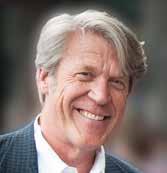
3
Exhibitions 2021–22
Sublime Sights: Ski Jumping and Nordic America
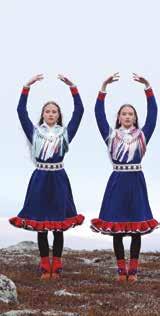
April 17, 2021–July 18, 2021
“To see how an expert ski jumper executes a jump is one of the most sublime sights the earth can offer us.”
—Fridtjof Nansen, polar explorer

Organized by the National Nordic Museum and the Washington State Ski & Snowboard Museum, this exhibition examines how early Nordic-American athletes connected to their adopted land through the sport of ski jumping. It features ski equipment and memorabilia, photographs, film clips, and oral history interviews to show the sport’s development and demonstrate its cultural significance. THIS EXHIBITION IS SUPPORTED BY PEOPLES BANK .

Among Forests and Lakes: Landscape Masterpieces from the Finnish National Gallery
May 6, 2021–October 17, 2021
Drawn from the Ateneum Art Museum/Finnish National Gallery’s collection, this exhibition considers how Finnish artists have depicted the landscape of their native country since the mid-nineteenth century. Over 50 paintings, works on paper, and video art cover more than 150 years and 800 miles from the coast and archipelago in the south to the Arctic Ocean in the north. Among Forests and Lakes is organized into four themes and includes well-known Finnish and Sámi artists such as Akseli Gallen-Kallela and Marja Helander. THIS EXHIBITION IS SUPPORTED BY ANN-CHARLOTTE GAVEL ADAMS, THE BARBRO OSHER PRO SUECIA FOUNDATION, AND THE ROBERT LEHMAN FOUNDATION
Dines Carlsen: In His Own Manner
July 22, 2021–October 24, 2021
In 1916, American artist William Merritt Chase saw the work of fifteen-year-old Dines Carlsen exhibited at the National Academy of Design, and he predicted “a future of great brilliancy” for the teenaged artist. Dines’s father, Danish-born artist (Søren) Emil Carlsen, had risen to prominence as a skilled painter of still lifes, seascapes, landscapes, and portraits. Because the Carlsens shared a studio and the spotlight, reviews focused on their familial bond. Upon the death of his father in 1932, Dines relocated permanently to northwestern Connecticut, where he developed a style distinct from his famous father. In this dynamic exhibition, visitors will enjoy a rotating selection from the collection of the National Nordic Museum, which received a gift of more than 900 works by the artist in 2020. THIS EXHIBITION IS SUPPORTED BY THE SCAN DESIGN FOUNDATION.
4
Paper Dialogues: The Dragon and Our Stories
October 28, 2021–January 31, 2022
Paper Dialogues pairs the work of contemporary paper-cutting artists Karen Bit Vejle, Layla May Arthur, Emma Reid, and Qiao Xiaoguang. The mythical dragon motif figures prominently in British, Chinese, and Nordic visual culture. Through shared subject matter and medium, Arthur, Reid, Qiao, and Vejle initiate a cross-cultural conversation that offers personal interpretations of the histories and traditions of their home regions. THIS EXHIBITION IS SUPPORTED BY 4CULTURE, ARTSFUND (GUENDOLEN CARKEEK PLESTCHEEFF GRANT), AND THE SCAN DESIGN FOUNDATION.
M(other) Tongues: Bodhild and Las Hermanas Iglesias
October 28, 2021–January 31, 2022
This exhibition examines the Iglesias family’s artistic collaborations. The fiber art of Norwegian-born Bodhild Iglesias is displayed alongside the works on paper of her daughters Janelle and Lisa Iglesias. The family considers artistic traditions of Norwegian and Dominican cultures passed down from each generation. Inspired by the “mother of modern textiles” Anni Albers (1899–1994), the three artists translate abstract motifs from one medium into another. Interpretation of the exhibition is offered by Bowie, Bodhild’s grandson, who leads visitors on an audio-guided tour. The artists will also participate in the biennial Nordic Knitting Conference in November 2021. THIS EXHIBITION IS SUPPORTED BY 4CULTURE AND ARTSFUND (GUENDOLEN CARKEEK PLESTCHEEFF GRANT).
COVER IMAGE
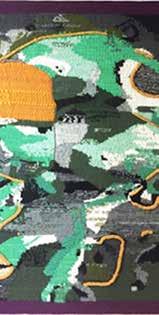

Hugo Simberg, Spring Evening, Ice Break, 1897, oil, Finnish National Gallery / Ateneum Art Museum.
Photo: Finnish National Gallery / Hannu Aaltonen
EXHIBITIONS 2021–22 | 5
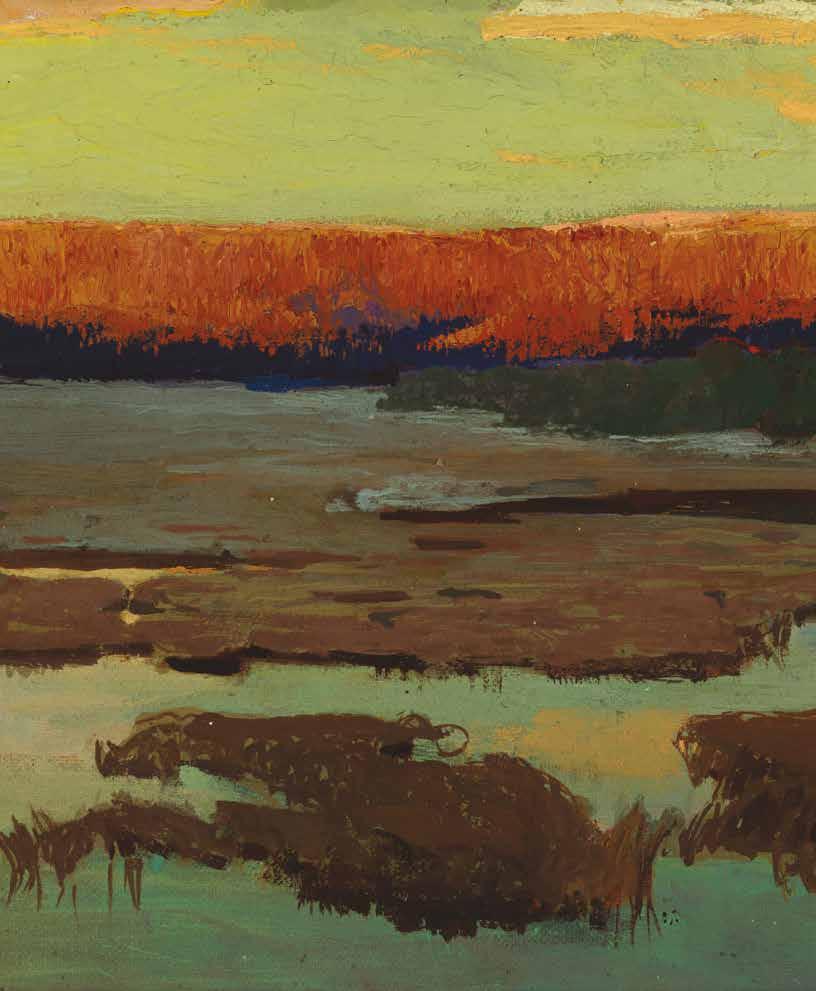
6 | NORDIC KULTUR Exhibitions 6 | NORDIC KULTUR Finnish National
/
Gallery
Hannu Pakarinen
Among Forests and Lakes: A conversation with the curators
by Leslie Anne Anderson, Director of Collections, Exhibitions, and Progams
In preparation for our summer 2021 temporary exhibition, Among Forests and Lakes: Landscape Masterpieces from the Finnish National Gallery, the Museum spoke with curators ANU UTRIAINEN and HANNE SELKOKARI to gain deeper insight and context on this superlative show of work by some of Finland’s most famous artists.
LESLIE ANNE ANDERSON: Why has landscape been a significant genre in Finnish art?
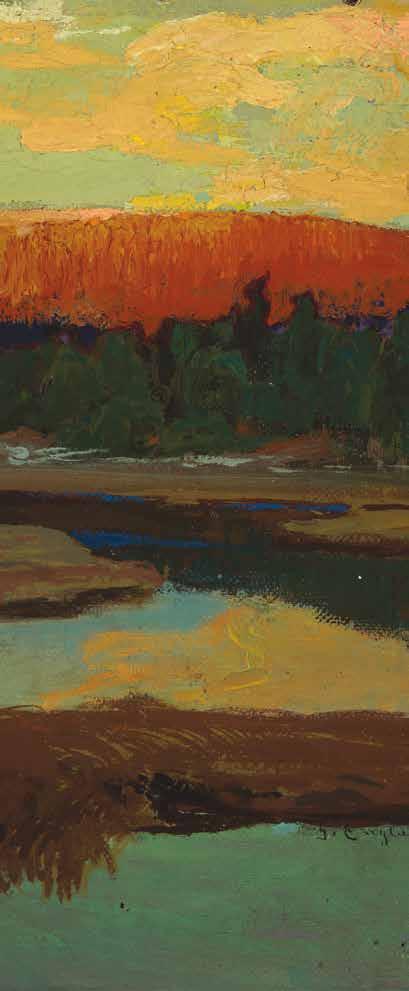
ANU UTRIAINEN: Landscape themes emerged as a category of European art during the nineteenth century. Previously, they had generally served as backdrops for other types of works, such as paintings with historical, mythological, or religious subject matter. As such, landscapes were not often explored as an independent genre by artists.
The rise of landscape painting has its roots in the French Revolution and the Napoleonic Wars. Along with its spread emerged the ideal of nationalism, national self-rule, and the need to create unified national culture. In Finland, the era of building a national identity is linked to the birth of the concept of “Finnishness.” This concept took form mainly in literature and poetry in the first decades of the nineteenth century—at that time, Finland was a Grand Duchy of the Russian Empire. The idea of an independent nation created a strong need to depict the country and its people in visual form. One of the most significant landscape painters of the first half of the century was Werner Holmberg (1830–1860), who studied in Düsseldorf, Germany. Holmberg adapted the themes and ideas of Romantic landscape painting to the Finnish environment.
AMONG FORESTS AND LAKES | 7
This was a pioneering project as there were no professional Finnish artists or public art museums in Finland until the Finnish Art Society (established 1846) began to collect artworks through donations, commissions, and purchases, and established the Drawing School in the mid-nineteenth century. The aim was to amass a collection of Finnish art for public display. This momentous campaign culminated in the inauguration of the Ateneum building in 1887, consisting of two art schools, the Art Society’s offices, and an art museum for the collections. By that time, landscape painting had achieved a key role in the newly established art scene.
Even today, landscapes are greatly loved by Finnish museum visitors; and landscape painting as a genre and means of artistic expression is popular among contemporary visual artists.
LAA: This exhibition shares 150 years of artwork. How has the depiction of the Finnish landscape changed in the 150 years represented in the exhibition?
HANNE SELKOKARI: The ways to experience and express the landscape and nature varies in methods, but many ideas conveyed through it remain the same. Evoking the sublime in the viewer, which was the aim of the early artist, progressed into showing details of nature through careful studies executed in nature like in Holmberg’s sketches; or depicting snow and ice in a variety of ways with different techniques from Fanny Churberg to Väinö Blomstedt and H. Ahtela. Lea Ignatius and Aimo Kanerva are both masters of expressing the warm sun and heat in their works (Heat and Hot Day) by using just one radiant color.
An untouched lake landscape seen from a bird’s eye view was, for a long time, an ideal type of Finnish landscape. Symbolist landscape painting began in the 1890s, and as a style, is still strongly present in contemporary art. The Finnish landscape is not just countryside and pure nature. It is present in built environments or cities. The idea [that manufactured environments could be landscapes] originally came from the writer and historian Zachris Topelius, according to whom nature, people, and culture are a single entity. An opposite view was held by the poet J. L. Runeberg, whose romantic idea was that untamed nature and pristine wilderness represent the very opposite of culture and were important for that very reason.
LAA: The exhibition is divided into four themes—Seasons, Inside the Landscape, Symbolist Landscape, and Sápmi. Why did you decide to organize this exhibition thematically versus chronologically? How did you identify these four themes?
AU: There are certain recurring types and forms of landscapes, out of which the most canonical one is a view over a lake seen from a high vantage point. Another common feature are depictions of the four seasons, out of which winter landscapes can be mentioned as typically Finnish, especially at the turn of the twentieth century. At the same time, Symbolism in general—and Symbolist landscape painting in particular—were significant stylistic and philosophical movements and genres in Finnish art, so it was obvious they would play a role in this show as well.
PREVIOUS SPREAD
Gabriel Engberg, Landscape from Sápmi, Summer Night, 1898, oil, Finnish National Gallery / Ateneum Art Museum, Hoving Collection.
FACING PAGE
LEFT TO RIGHT FROM UPPER LEFT
Anton Lindforss, Autumn, 1941, oil, Finnish National Gallery / Ateneum Art Museum, Hoving Collection.
H. Ahtela, Winter Road, 1952, oil, Finnish National Gallery / Ateneum Art Museum, Ester and Jalo Sihtola Fine Arts Foundation Donation.
Akseli Gallen-Kallela, Winter, study for the Juselius Mausoleum frescoes, 1902, tempera, Finnish National Gallery / Ateneum Art Museum, Antell Collections.
Akseli Gallen-Kallela, Wild Angelica, 1889, oil, Finnish National Gallery / Ateneum Art Museum, August and Lydia Keirkner Fine Arts Collection.
Lea Ignatius, Heat, 1974, etching, relief printing, Finnish National Gallery / Ateneum Art Museum
Werner Holmberg, Landscape from Kuru in Morning Light, 1858, oil, Finnish National Gallery / Ateneum Art Museum.
Sápmi in the north, on the other hand, is both a geographical and cultural region (the latter is referred to as Sápmi), and has enthralled artists ever since the 1920s when it became more accessible by car and train. The “magic” of north was thus an evident theme we could not ignore, and which has since become a very current topic in the discourse of decolonization and the rights of indigenous people.
In terms of motifs, forests, open fields, and lakes occur over and over again. After World War II, Finnish society changed radically. Urbanization and industrialization were rapid and sweeping. Finland turned from an agrarian country into a modern industrial society in a couple of decades. This had an effect in art and landscape painting as well, and cityscapes became a popular motif.
The curatorial process and organization of the show under these themes was actually pretty easy when we realized that the above mentioned are the most common motifs and topics, supplemented with urban landscapes from the modern era. Interestingly enough, the core concept of the “Finnish landscape,” created in the mid-nineteenth century, has survived over time. It has transformed many times in terms of style, technique, and form, but the initial idea of a pristine and intact landscape, or an image of it with a hint of human intervention, has never disappeared.
LAA: Many of the works included in the exhibition were created by canonical artists, while others are by less well-known artists. What was the process for selecting works of art for the show?
AU: The Ateneum is the biggest and most well-known art museum in Finland. The permanent collection exhibition, “The Stories of Finnish Art,” shows many of the most significant works from the late nineteenth to early twentieth centuries. In recent years, the collection’s timeline has been extended until 1970. Today, the Ateneum is not only a museum of older art, it also holds the biggest collection of modern art in Finland. We have been working on this part of the collection more
8 | NORDIC KULTUR
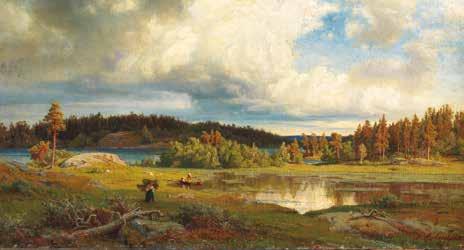
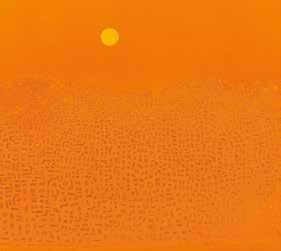


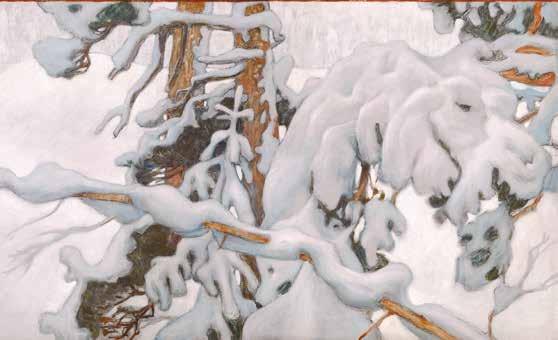
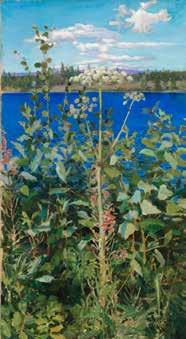
AMONG FORESTS AND LAKES | 9
Finnish National Gallery / Jenni Nurminen
Finnish
National Gallery / Ainur Nasretdin
Finnish National Gallery / Hannu Pakarinen
Finnish National Gallery / Jenni Nurminen Finnish National Gallery / Hannu Aaltonen
Finnish National Gallery / Hannu Pakarinen
intensely, making the modern collection more accessible to our visitors, at home and abroad.
Another important factor is emerging areas in art historical research. This has had a ground-breaking effect in the way we analyze and study those parts of the collection that may have fallen off our radar in recent decades. The concepts of good taste or style have changed and, for example, climate change, rising interest in environmental issues, and processes and concepts like decolonization or posthumanism are examples of new ways of seeing. Landscapes and cityscapes are at the very center of these issues.
You can’t talk about Finnish art and not mention the role of Finnish women artists. They have always played a central and significant role in the Finnish art scene. Women artists have embraced new trends and ideologies in a pioneering way, and shaped the way modernism and modernistic styles were adopted in Finnish art at the turn of the twentieth century and after. They also have an essential role in this display as well. Women might not yet be as canonical and acknowledged internationally as they are in Finland, but we are putting lots of effort toward making a change here. As an example, our Modern Woman project, with four modern women artists, has been shown in New York City, Tokyo, Stockholm, and it just opened in Copenhagen. Helene Schjerfbeck (1862–1946), one of the most well-known Finnish artists, was on display at London’s Royal Academy of Arts last year.
These are just examples of how art history, general opinions, and objects of interest are changing as the world is rapidly changing around us. We think museums and curators have an essential role in addressing these issues.
LAA: Can you explain the collecting history of the Ateneum, and the efforts made in this exhibition to include works by Sámi artists from the collection of the Museum of Contemporary Art Kiasma (part of the Finnish National Gallery)?
HS: The Ateneums’s collection started in the mid-nineteenth century with acquisitions by the Finnish Art Society. Landscape painting in its different phases and themes was and is one of the mayor interests in the collection, not least because Finnish artists have always been keen to study and paint nature.
Works by both Sámi artists and contemporary artists are fairly new acquisitions for the Finnish National Galleryand are part of Kiasma’s collection. Our aim as curators was to show work by artists from all parts of Finland. We wanted to represent landscapes from all over the country by as wide a range of artists as possible.
LAA: This is a major exhibition and the National Nordic Museum is the exclusive North American venue. How often do works like Hugo Simberg’s Spring Evening, Ice Break travel to institutions outside Helsinki, Finland, or Europe?
HS: Actually, Simberg’s painting has been on the move for the last twenty years and in at least eighteen exhibitions! Ateneum Art Museum arranged an extensive exhibition on Hugo Simberg with several publications in 2000. Before this solo exhibition,
Simberg was known and loved in Finland, but over the last twenty years, his paintings (and sometimes also drawings) have played an important role when depicting turn-of-the-century Finnish art abroad. Spring Evening, Ice Break is one of the small treasures of the Symbolist period in Finnish landscape art. The last time this piece was shown in North America was in 2007 in Minnesota.
LAA: What have you discovered in researching this exhibition that surprised, challenged, or expanded your understanding of Finnish art?
AU: I find myself in continuous state of awe and astonishment when working with our marvelous collection. I really enjoy studying it and trying to find new ways of putting our works of art in a context that gives museum visitors new perspectives, experiences, and ways of thought. Because I have worked with the collection for many years, the most interesting part is the modern collection. It has not been studied or shown as much as the older part, and it gives me great joy to make discoveries.
Women artists are one of my special interests—painters, printmakers, and sculptors—and how they were able to build their careers as professional artists.
It was not a surprise to find that there are lots of images of lakes, forests, and fields, but it was a bit of a surprise that there are so few seascapes and images of the archipelago, even though they are an essential and huge part of the Finnish landscape. One answer to this is political—artists were interested in the more unknown and untouched hinterlands, the original “Finnish” inland, as they were commissioned to give it a visual form as a national landscape. Seashore was considered to be more civilized. Language was an important factor—the coastline was more inhabited by the Swedish-speaking population, including most of the artists themselves who came from the Swedish-speaking upper classes until the early decades of the twentieth century, and therefore, it might not have been considered as a genuine Finnish landscape.
In general, this project has only strengthened my presumption of the landscape as one of the most essential and widespread themes in Finnish art of all times.
Among Forests and Lakes: Landscape Masterpieces from the Finnish National Gallery features over fifty works of art that span over 150 years of history, from the 1850s to the present day. Among Forests and Lakes is on view at the National Nordic Museum May 6, 2021 through October 17, 2021.
For more information on the Ateneum’s collecting history, visit ateneum.fi/ en/the-story-of-ateneum/
View the Ateneum’s entire digital collection at kansallisgalleria.fi/en/search
Leslie Anne Anderson is Director of Collections, Exhibitions, and Programs at the National Nordic Museum. A former Fulbright grantee to Denmark and American-Scandinavian Foundation Fellow, Leslie specializes in 19th-century Nordic art. Her curatorial work has received the Award for Excellence from the international Association of Art Museum Curators. She has published articles in numerous scholarly journals, and she serves on the editorial board for the peer-reviewed journal Arts. Born to a Cuban mother and a Danish-American father, her current curatorial interests lie in contemporary cross-cultural artistic conversations.
10 | NORDIC KULTUR
The National Nordic Museum Acquires a Swedish Royal Tapestry
 by Leslie Anne Anderson, Director of Collections, Exhibitions, and Programs
by Leslie Anne Anderson, Director of Collections, Exhibitions, and Programs
Museum Officially Names The Barbro Osher Gallery
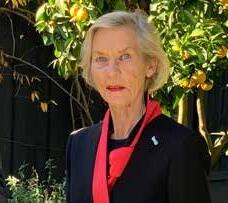
In 2021, the Museum’s large temporary exhibition gallery will be renamed The Barbro Osher Gallery in recognition of the philanthropist’s generous support for the Museum’s capital campaign. The first exhibition to be held in the newly-renamed gallery will be the landmark exhibition Among Forests and Lakes: Landscape Masterpieces from the Finnish National Gallery. The 3,700 squarefoot gallery is among the Museum’s most frequented spaces and the site of at least three major special exhibitions each year. Built to Smithsonian standards, this state-of-the-art gallery allows the Museum to display loaned works from world-class institutions.
On December 1, 1928, Swedish Count Folke Bernadotte of Wisborg (1895–1948), son of Prince Oscar Bernadotte and nephew of King Gustaf V, wed the daughter of an American industrialist, Estelle Romaine Manville (1904–1984), at Saint John’s Episcopal Church in Pleasantville, New York. Theirs is believed to be the first European royal wedding officiated in the United States.
To commemorate their union, the Count and Countess Folke Bernadotte commissioned from Swedish artist, author, and ethnologist Ossian Elgström (1883–1950) a tapestry depicting the arrival of Norse explorer Leif Eriksson on the shores of North America around the year 1000 CE. The subject matter references the couple’s roots and the shared history of the Nordic countries and North America. It was woven between 1929 and 1930 by the studio at Sankta Birgittaskolan, operated by Swedish textile artist Emy Fick.
Elgström’s design evokes the period it depicts. At upper center, the work’s title Leif Eriksson upptäcker Vinland (Leif Eriksson Discovers Vinland) is written in what resembles a runic script. In the upper right corner, a personified easterly wind propels the stylized Viking ships and their crews toward the Western Hemisphere. The aurora borealis and constellations of stars illuminate the ships’ route. In the foreground, several Vikings reach the shore to find fertile ground. The growth of grapes alludes to the name Eriksson bestowed on the region—Vinland (Land of Wine).
Several publications, including Ord och Bild (Word and Image) in 1929 and The American-Scandinavian Review in 1936, featured the tapestry. The tapestry was shown in the 1930 Stockholm Exhibition and the 1933 Chicago World’s Fair. Nearly ninety years later, plans for its preservation and future display are currently underway. This important textile entered the National Nordic Museum’s permanent collection in 2020 thanks to a generous gift from Barbro Osher.
(608) 687-4299
LefseTime.com

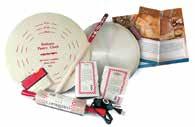
For all your Scandinavian Cookware & Gift Needs, it’s.... Lefse Time!
SWEDISH ROYAL TAPESTRY | 11 Collections
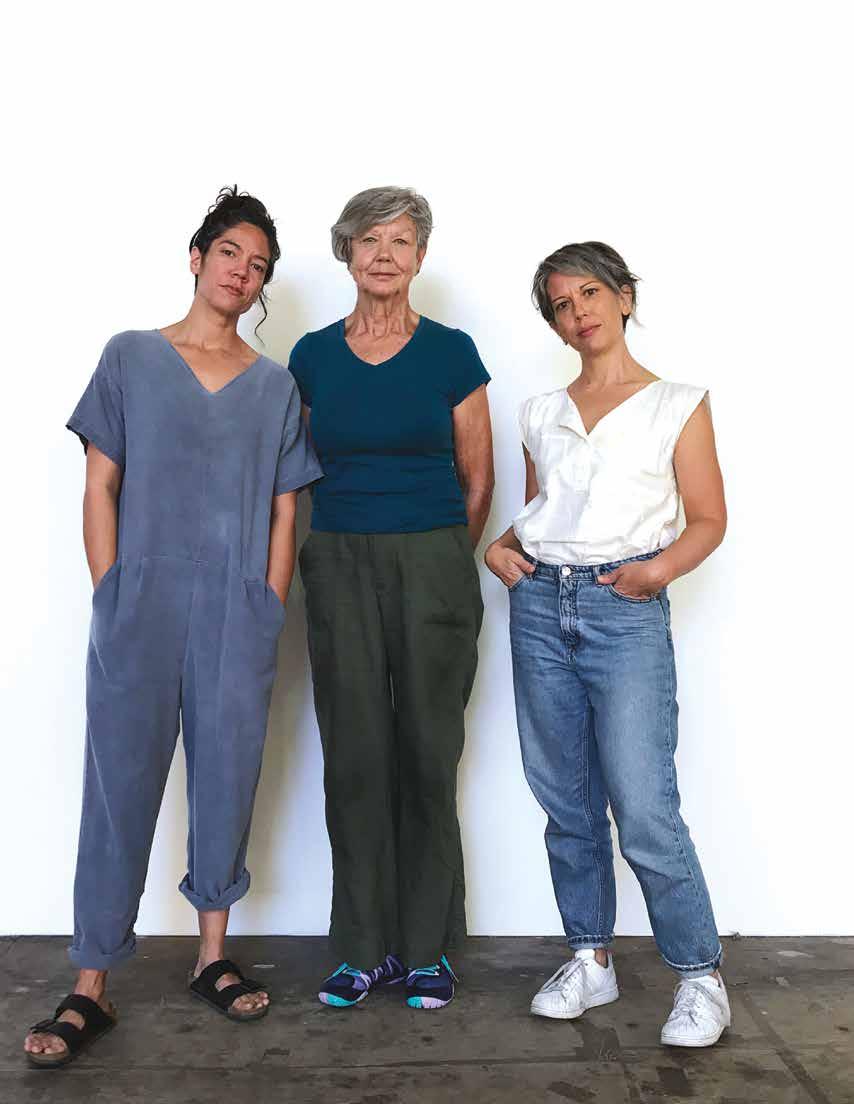
12 | NORDIC KULTUR Exhibitions
Janelle, Bodhild, and Lisa Iglesias. FACING PAGE Bodhild, Janelle, and Lisa Iglesias, Knit painting (2019), quilted acrylic yarn, stretched over metal frame.
Image Credit: Christine Sloan Stoddard
IN FALL 2021, the National Nordic Museum hosts an exhibition of works titled M(other) Tongues: Bodhild and Las Hermanas Iglesias by a family of women artists—Bodhild, Janelle, and Lisa Iglesias—with roots in Norway and the Dominican Republic. Though currently located on opposite coasts, sisters Janelle and Lisa often create project-based work as a pair under the name “Las Hermanas Iglesias” (Spanish for “The Iglesias Sisters”), a reference to the Spanish surname of their Dominican father Bienvenido. They have individual artistic practices and careers: Janelle is Assistant Professor of Studio Art at University of California San Diego and creates objects and installations that are three-dimensional, while Lisa is Associate Professor of Art at Mount Holyoke College and prefers the two-dimensional mediums of drawing and painting. They impart their expertise as educators, nurturing aspiring artists. However, when partnering on a project, their work considers their roles as sisters, mothers, and daughters. For the show M(other) Tongues: Bodhild and Las Hermanas Iglesias, they enlist the textile talents of their Norwegian-born mother Bodhild, a fiber artist, to expand the conversation across mediums. In preparation for their first exhibition in the Pacific Northwest, I sat down with Janelle and Lisa to discuss the importance of identity and heritage in their contemporary collaborative practice.
LESLIE ANNE ANDERSON: Lisa and Janelle, you collaborate with each other as Las Hermanas Iglesias. How does the work of this artistic collaboration differ from or extend your individual practices?
LAS HERMANAS IGESIAS: At the very beginning of our collaborations in 2005, we thought of our working-together as something very separate from what we did in our individual studios. The flexibility to experiment, break our own rules, and try
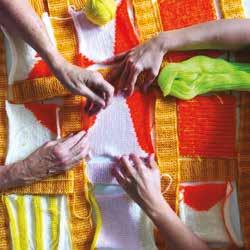
new things has always been woven into our collaboration, so our philosophy about the structures of our relationship has naturally shifted over time. . . . We think of Las Hermanas Iglesias now as a separate enti-
M(OTHER) TONGUES: BODHILD AND LAS HERMANAS IGLESIAS
LAA: Explain the genesis of your artistic collaboration with each other and with Bodhild. When did you decide to include the artistic perspectives of Lisa’s son Bowery (Bowie Gerlitz) Iglesias and Janelle’s baby August Som-Iglesias?
By Leslie Anne Anderson, Director of Collections, Exhibitions, and Programs
ty from our individual practices, yes—but binaries and borders don’t apply here—our work as Las Hermanas Iglesias has fluidly evolved to intermingle with, borrow from, and thread through our individual studios and frequently extends to other makers, communities, and family members. Perhaps a difference between this collaboration and our individual practices might be that a certain kind of multiplicity—a relational identity, our familial connection—is foregrounded as central to the premise of our collective work.
LHI: We celebrate and acknowledge that we’ve been collaborating with our mother in various ways since gestation—the connections that have physically and emotionally bound us to each other have affected every detail, every gesture in our lives. The first time we worked with our mother to create a deliberate and collaborative artwork object involved our invitation for her to knit a conjoined dress for us. We wanted a garment that would visualize this physical binding, a dress we could wear together while performing tasks like creating artworks or attempting to walk in opposite directions. As our collaboration as Las Hermanas Iglesias gradually became more complicated in terms of relationships and structures for working together, so too our desire to work more directly and intimately with our mother grew, adapting to her increased availability after retirement from teaching in the elementary public school system, our father’s death, and mirroring our own instincts towards incorporating more of the familial, maternal, and textile. In extending our respect for how knowledge is passed between generations, it just follows organically that we invite Bowie’s contributions and honor this child’s interpretations of these practices.
LAA: As Las Hermanas and Familien Iglesias, you have examined transnational identity. Your mother Bodhild was born in Norway, and your father Bienvenido was Dominican. What aspects of Norwegian and Dominican cultures inform your work?
LHI: Our work reflects the mashups and hybridic qualities we experience through
AN INTERVIEW WITH ARTIST DUO LAS HERMANAS IGLESIAS | 13
our autobiographies. There are unique relationships and constellation points between our parents’ home countries, including the cod fish—an important export in Norway (klippfisk) and one of the national dishes in the Dominican Republic (bacalao). We grew up within a variety of colliding cultural traditions, expectations, and motifs. We are shaped by and interested in the static and the ways that these qualities counteract and intersect each other, and we also experience many parallel values that Latinx and Scandinavian cultures share. Some of the shared values inherited from our parents that actively inform our work include a persistent transformation of materials, an intense respect for mending, an assumption of re-use and collection, a re-consideration or re-activation of ideas and objects, a love and reverence for the hand made, and an appreciation for using things at hand to problem solve.
LAA : Did you travel frequently to Norway in your youth? What were your impressions of your mother’s native country?
LHI: We grew up in Queens, very geographically distant from our relatives in the Dominican Republic and in Norway. We didn’t go to Norway very often at all in our youth— our mother took us with her to visit family
as infants, and we went again with her for a week to the small mountain farming town when we were sixteen and seventeen years old. One of the most striking impressions of our mother’s native country was the presence of a large family—and the feeling that we were deeply loved by a group of people outside of our home in Hollis. The stories and imaginations of her upbringing that had always been close at hand now gathered the tangibility of the touched and witnessed—the proximity of school to home for commute by skis, the grass grown on the roof to at times be mowed by goats, the impossibly-dated year of her home’s construction chiseled into rafters. These layers of the home and farm where she is from exist alongside her children’s own bridge and tunnel experience in Queens.
LAA: Your story resonates deeply with me, as a second-generation American and as a person who is both Hispanic and Nordic American, as well as with others who have had multicultural upbringings. Did you initially seek to bridge cultures and communities through your collaborative work?
LHI: Our identities as daughters and sisters, our parents’ experiences as immigrants, our upbringing as marked by the colliding and
overlapping of the cultures and knowledges of our parents—these layers and more are in the DNA of the work, and we hope that these layers translate in some way to the communities with which we engage. Unpacking our own identity—a feeling during childhood that we occupied an in-between space as we navigated our own definition of ourselves— has impacted our ways of working. The translation of ideas and patterns between participants and across mediums is inspired by the presence of multiple languages in the house. Our installations and object choices usually include references to the cultural traditions of our parents. We consider our work to be interdisciplinary and we resist a signature aesthetic or category for production, preferring to think of our practice as porous, ever-growing, and un-fixed.
LAA: The exhibition at the National Nordic Museum is multigenerational, and it celebrates motherhood in your own family. You also reference artistic motherhood with Anni Albers (1899–1994), who is considered to be the mother of modern textiles. Are there other creative maternal figures who have inspired you?
LHI: We’re influenced by the energies and contributions of so many artists who feel like

14 | NORDIC KULTUR
maternal figures—people who have generated paths we continue to walk. Anni Albers is a major inspiration as well as Mary Kelly, Lygia Clark, Lorna Simpson, Yoko Ono, Ruth Asawa, and Louise Bourgeois. . . . and inspired by how contemporary artists interweave their practices of family care and making as Wendy Red Star, Carmen Winant, Sheilah and Dani ReStack, Rachel Hayes, Lenka Clayton, and Andrea Chung do.
LAA: You are both professors who foster the development of artists at Mount Holyoke College and the University of California San Diego. How do your respective artistic philosophies inform your educational philosophies?
LH: Our artistic philosophies and politics regarding collaboration, experimentation, challenges to traditional hierarchies, and acknowledgements of privilege and power dynamics inform our pedagogy—resulting in syllabi and classroom cultures that value lateral learning environments, education, and thinking through materials and critical analysis of our actions. We’ve been deeply influenced by Paolo Freire, bell hooks, Audre Lorde, James Baldwin, Rebecca Solnit, and Sister Corita Kent in the studio and the classroom.
M(other) Tongues: Bodhild and Las Hermanas Iglesias is on display at the National Nordic Museum October 28, 2021 through January 31, 2022.
November 6–7 & 13–14
Classes, demos, talks, vendors, and special guests
nordicmuseum.org/knitting

15
Nordic Knitting Conference 2021
Photo by Solen Feyissa on Unsplash.
FACING PAGE Las Hermanas Iglesias in collaboration with Bodhild Iglesias, “ma is as selfless as i am” (grid) series, gouache and flashe on paper, acrylic and wool yarn, stretcher bars, 24x18 inches (knit paintings) 14x11 inches (works on paper).
Paper Dialogues: The Dragon and Our Stories
by Leslie Anne Anderson, Director of Collections, Exhibitions, and Programs
The artistic collaboration between Karen Bit Vejle and Qiao Xiaoguang was born in fire. In 2010, Sino-Norwegian diplomatic relations were strained when the Norwegian Nobel Committee awarded the annual Peace Prize to Chinese human rights activist Liu Xiaobo. Although bilateral relations normalized six years later, it was under these strained conditions that Vejle and Qiao’s cross-cultural conversation began.
With the support of the Norwegian government, Danish papercutting artist Karen Bit Vejle traveled to China in order to exhibit her work there. As an artist, Vejle draws inspiration from Norway’s medieval wood carvings and the nineteenth century papercuts of Danish Golden Age author Hans Christian Andersen. She is also knowledgeable about other cultures that have fostered the art of papercutting, including China. China witnessed the birth of the art form over 1,500 years ago: papercutting became a craft that thrived amongst women artists in rural areas who used it as a form of expression.
When Vejle visited this cradle of papercutting, she sought out a colleague with whom to collaborate on a project. Together, Vejle hoped, they could explore how their two cultures approach the same artistic medium. In April 2013, she met Professor Qiao Xiaoguang at the Central Academy of Fine Arts in Beijing, and they selected a common motif in Nordic and Chinese art—the dragon—to depict alongside each other. The dragon figures prominently in
Chinese culture throughout time and is an auspicious symbol (called “long”), while the Norse dragon is most often associated with the Viking period and the Middle Ages as an apotropaic (evil-repelling) symbol.
Though the artists spoke different languages and relied on translators for verbal communication, Vejle feels that she and Qiao are “like-minded” in their artistic philosophies, even while their styles and methods of display differ. For example, Vejle’s mounts sizeable papercuts between glass plates and relies on lighting the papercuts in such a way as to cast shadows, giving the two-dimensional works a three-dimensional, or sculptural, presence. These methods were new to Qiao. The artists’ works informed each other, as previous cultural encounters had on artists of earlier eras. One of Vejle’s papercuts produced during this collaboration alludes to earlier exchanges. One piece in the exhibition features a knitting pattern popularized by Norwegian women in World War II. The pattern became a cryptic symbol of camaraderie among compatriots, yet its origins are Asian.
Their cross-cultural approach lent itself to an exhibition that travels the world. Hosted by the ArtHouse Jersey in the Channel Islands in 2016, the exhibition Paper Dialogues expanded to include two new artists, Layla May Arthur and Emma Reid. It is this iteration of the exhibition that will travel to the National Nordic Museum in the fall 2021, encouraging American practitioners in the art of psaligraphy to join in the conversation.
16 | NORDIC KULTUR
Exhibitions
Paper Dialogues is on view at the National Nordic Museum October 28, 2021 through January 31, 2022.
FACING PAGE Karen Bit Vejle, Dragon Egg 2, 2014, paper, 31.5x39.3 inches.

PAPER DIALOGUES: THE DRAGON AND OUR STORIES | 17
History in the Making: Collecting Oral Histories in the Midst of a Global Pandemic
by Alison DeRiemer, Archivist and Oral History Specialist

IN SPRING 2020, as the COVID-19 health crisis cast a shadow of uncertainty upon nearly all aspects of global life, the National Nordic Museum embarked on a mission to document these remarkable times in the form of a new oral history initiative. A Pandemic Preserved: The COVID-19 Crisis in the Nordic Countries and the Pacific Northwest was launched.
A Pandemic Preserved expands on the impressive body of interviews already gathered by the Museum. These recordings supplement ongoing oral history initiatives at the Museum, which, to date, include nearly 1,000 oral histories of Pacific Northwesterners with ties to the Nordic countries.
Part of the Museum’s longstanding and uninterrupted tradition of collecting oral histories, Nordic American Voices (NAV) was started by Museum volunteers in 2009 and is still coordinated by this dedicated core group of supporters over a decade later. As of February 2020, NAV has collected a remarkable 750-plus interviews, focusing on stories from Nordic immi-
“When we disembarked, there was a whole line of CDC personnel. They all had black uniforms, and they all had masks, and some of them had eye shields. They were all lined up. It was just disconcerting. Then, I think we were screened initially before we went through customs. So, we lined up. We were supposed to stay six feet apart, you know, the usual, but of course, it doesn’t always happen that way, because people are anxious.”
—Marjorie Graf, Seattle, May 18, 2020
grants and their descendants in the Pacific Northwest. Prior to the COVID-19 pandemic, NAV kept a busy schedule, conducting eight interviews nearly every month since its inception. Hundreds of these interviews are available on the Museum’s website; many more are scheduled for inclusion in the future. Additionally, NAV has produced two documentaries related to oral histories from the Second World War as well as a book, copies of which are available for sale in the Museum Store.
Launched in 2016, Interwoven is Museum’s project dedicated to collecting oral histories that examine culture and identity from individuals with blended heritage. The first phase of this project focuses on individuals of Nordic and Native American descent. Interwoven was the subject of two symposia in recent years in partnership with the Tulalip Tribes’ Hibulb Cultural Center.
As NAV and Interwoven paused their work for health and safety reasons in early 2020, the Museum shifted its focus to collecting oral histories related to the current global crisis. The

18 | NORDIC KULTUR
Collections
All photos by Laura Cooper.
“We have other crises around the corner. We have the climate crisis. Even though we try to shut our eyes as hard as we can to not recognize this, we keep on living like we don’t have a climate crisis. My hope is that maybe we’ll realize when we’re in the middle of this [pandemic] what is important in our lives. Is it to be able to buy more stuff, junk, gadgets, whatever? Or is it to have a healthy family and friends that you can be with?”
—Goran Andersson, Köping, Sweden, May 19, 2020

“The first two flights—one from Seattle to Detroit, and then from Detroit to Amsterdam, went fine. It became a very eerie feeling, because the plane was onethird full, which was great, because we kept our distances. And we had to wear masks. At that time, they had started to require masks. But arriving in Amsterdam, it was a totally different thing. There, people were milling around. Most people did not wear masks. The plane to Copenhagen was absolutely filled, and that was quite scary, actually.”
—Marianne Forssblad, Halland, Sweden, June 18, 2020
“It wasn’t meant to, but the upper side of my hand touched the upper side of his hand for like half a second, and then I realized, this is the only human touch contact I’ve had in three, four, five weeks, and that’s depressing.”
—Kristin Stoltz Thomassen, Oslo, Norway, June 24, 2020
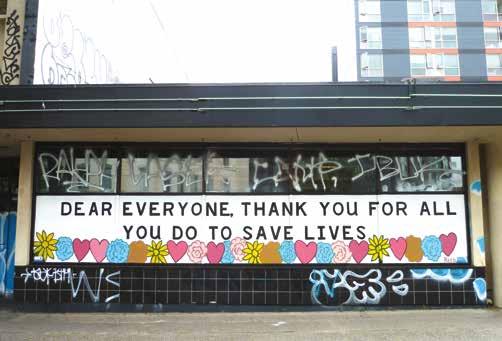
National Nordic Museum is not alone in this pursuit; many other museums, universities, cultural institutions, and individuals are documenting the pandemic as well. When determining how this oral history project could best represent the pandemic, the Museum felt it was important to take advantage of the institution’s role as an internationally-focused museum. This makes A Pandemic Preserved the Museum’s first oral history project to collect stories internationally. Participants represent both the Pacific Northwest—the first United States epicenter of the disease—as well as all five Nordic countries. Through this broad lens, life during a global pandemic is being preserved and shared.
As of August 2020, eighteen interviews (with twenty-two narrators) have been completed for this ongoing oral history project. Interviews are conducted remotely via the video conferencing software, Zoom. The project’s participants represent a wide array of backgrounds and job sectors, including education, healthcare, and the arts, among several others. Discussions have centered
on the numerous ways in which the pandemic has affected lives, work, and outlooks on the future. Many narrators have relayed personal stories and candid perspectives, adding an intimacy and depth to these discussions.
This project is just beginning. Throughout 2020 and these next several critical years, the Museum will continue to collect these personal experiences as the global story unfolds. Each of the stories collected will be preserved for future generations, which will undoubtedly find oral histories to be an invaluable resource in studying our era.
Full interviews, videos, and transcripts can be found at nordicmuseum.org/collections
Copies of the NAV documentaries and book can be purchased at nordicmuseum.org/museumstore
More of the Museum’s oral histories can be heard at nordicmuseum.org/ collections
HISTORY IN THE MAKING | 19
PAGES 18–20 Seattle artists painted murals on shuttered Ballard businesses during the height of the pandemic.
“Right away, after [I was diagnosed with COVID-19], the Icelandic health system took over, so to speak. We got phone calls every day. It was a very nice kind of secure feeling. You were not alone, somehow.”
—Jón Ársæll Þórðarson, Reykjavík, Iceland, May 14, 2020
Alison DeRiemer is the Archivist and Oral History Specialist for the National Nordic Museum. In her spare time, you might find her wandering the beaches and forests of the beautiful Pacific Northwest. The next Nordic country she plans to visit is Finland.
“We had three layovers. On the first flight, there were four people—four passengers, and four flight attendants on the whole plane. So, they were joking about it, being like a private flight. They gave us lots of stuff for free, like food and stuff. It was a really bizarre feeling. But the other flights were pretty normal, [but] people were very worried. It was kind of a tense feeling.”
—Love Karlsson, Stockholm, Sweden, May 16, 2020
“For my son, I think what’s hard for him, when you’re eight, you’re not texting with your friends. Zoom is awkward. For him, we’re really his only social outlet. What’s been incredibly hard is that he sees us all day long, and he hears us all day long, but we’re unavailable to him. And when you’re eight years old, that feels like a rejection: to see your parents, to hear them talking, to have them 20 feet away, but have them saying, ‘You need to do something else right now; I can’t play with you; I can’t watch a video with you.’ You know, I think for him, it feels extra lonely.”
—Julie Lowe, Seattle, May 4, 2020
June 19–26

Virtual Northern Lights Auktion 2021



A benefit for the National Nordic Museum
nordicmuseum.org/auktion
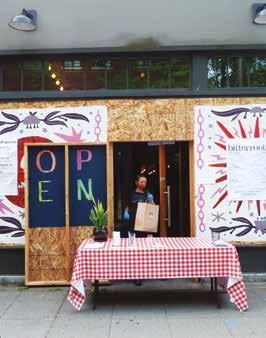
20 | NORDIC
KULTUR
All photos by Laura Cooper.
Nordic Women in Leadership Series
BRINGING TOGETHER TOP FEMALE EXECUTIVES from the Nordic countries and the Pacific Northwest, the Nordic Women in Leadership series will host three lively, interactive discussions in 2021. These leaders will join the Museum virtually to discuss the challenges and successes they have experienced as principals in their respective fields.
“Female-Founded Startups and the Investing Journey,” scheduled for May, will examine entrepreneurship in the Nordic countries and in the United States. The second panel in the series, “Nordic Women in the Cultural and Creative Sectors,” premieres in July. This panel will convene directors of major art and cultural history museums as well as heads of philanthropic organizations in the Nordic countries and be moderated by an American arts leader. “Making a Mark on the West Coast” is the final panel of 2021, scheduled in September. This talk will include three Nordic and Nordic-American women leaders in different industries—information and communication technology, food, and service industries—all based on the Pacific Coast of the United States.
Discussions center on a comparative look at opportunities for women in both the Nordic region and the United States, and the panels will offer actionable steps for aspiring women leaders to achieve success in business. The 2021 panels follow on the success of the first Nordic Women in Leadership event at the Museum, held virtually in August 2020. The conversation between two Swedish-born CEOs, fashion designer Gudrun Sjödén and head of the outdoor recreation company Hilleberg the Tentmaker and Honorary Swedish Consul Petra Hilleberg, attracted over 450 participants and continues to capture new views on YouTube.
Food Security and Sustainability Series
IN THIS TIMELY NEW SERIES OF TALKS , the National Nordic Museum brings together leading innovators and advocates for sustainable food practices and conservation who will discuss solutions to contemporary issues in the areas of fine dining, food processing, and agriculture. These leaders from the Nordic region and Washington State increase awareness and inspire positive actions for a more secure and sustainable world.
Beginning in May 2021, these talks will share the latest industry news and sustainable practices. The first panel, “Fine Dining for All: How Chefs Fed Communities during COVID-19,” explores how fine dining pivoted during the COVID-19 pandemic to instead serve food-insecure households or adopt new business models. “Tastemakers: Effecting Change in Food Processing and Packaging” investigates how companies in the Nordic countries and the United States demonstrate their commitment to sustainable strategies to minimize waste. The third panel, “Preventing the Collapse of Colonies: Saving Bees and the Global Food Supply” gives the latest buzz on the cultivation of plant-based foods plus efforts to combat declining populations of the world’s most important pollinator. And finally, “Finding Solutions to Food Waste” shares creative ways to make food waste a thing of the past.
May 2021
June 2021
July 2021
August 2021
Fine Dining for All: How Chefs Fed Communities During COVID-19
Tastemakers: Effecting Change in Food Processing and Packaging
Preventing the Collapse of Colonies: Saving Bees and the Global Food Supply
Finding Solutions to Food Waste
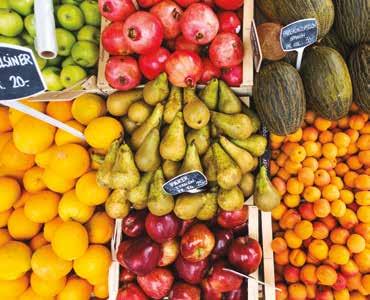
May 2021
July 2021
Female-Founded Startups and the Investing Journey
Nordic Women in the Cultural and Creative Sectors
September 2021 Making a Mark on the West Coast

21
Photo by Karl Magnuson on Unsplash. Photo by Jakub Kapusnak on Unsplash.
Innovation
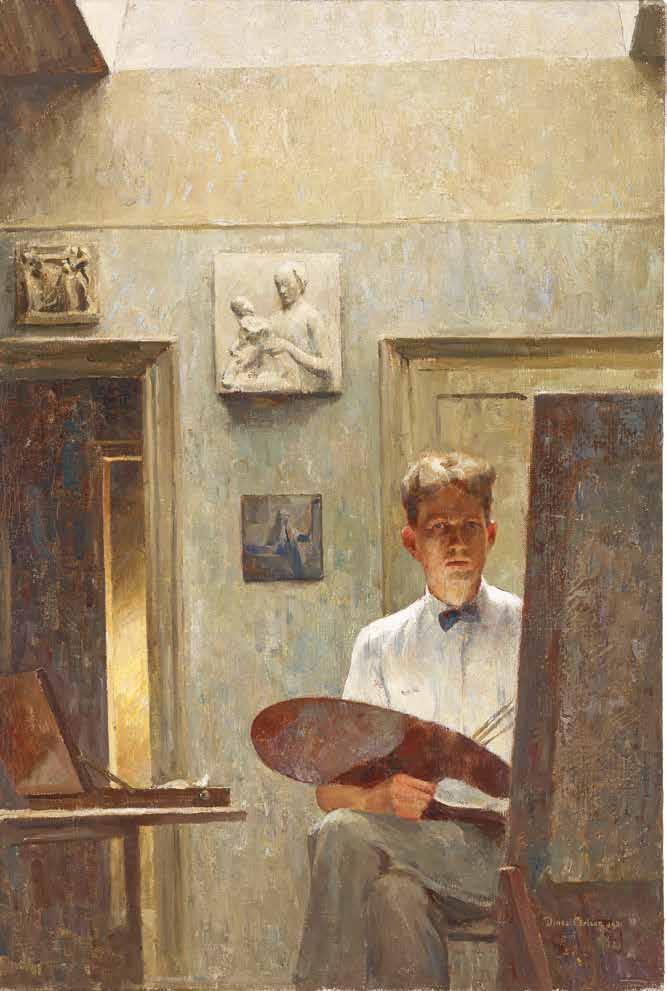
22 | NORDIC KULTUR Exhibitions
In the Studio of DanishAmerican Artists Emil and Dines Carlsen
by Leslie Anne Anderson, Director of Collections, Exhibitions, and Programs
THE MUSEUM’S LARGEST acquisition of art occurred in 2020. The Indianapolis Museum of Art at Newfields gifted nearly one thousand works by artist Dines Carlsen (1901–66), son of famed Danish-born American painter (Søren) Emil Carlsen (1848–1932), to the National Nordic Museum. Along with the Smithsonian’s Archives of American Art, the Museum has become the primary repository for materials related to the artistic family. The new collection had long been familiar to this article’s author, who researched the works extensively at Indianapolis from 2014 until 2015. While the senior Carlsen was well known at the time, it soon became apparent through this research that the accomplished and prolific junior Carlsen merits more attention than scholars previously paid him.
In spring 1916, fifteen-year-old artist Dines Carlsen exhibited a still life painting at the National Academy of Design, a New York City institution committed to the instruction and exhibition of its members. There, the painting caught the eye of American artist and tastemaker William Merritt Chase (1849–1916), who purchased it. After Chase acquired the painting, The American Magazine of Art predicted that “a
future of great brilliancy” awaited the teenage painter. In 1920, Dines’s painting The Jade Bowl (1919; fig. 1) received the Academy’s prestigious Hallgarten Prize. The Friends of American Art for the collection of the John Herron Art Institute (now the Indianapolis Museum of Art at Newfields) acquired the painting shortly thereafter. At the age of twenty-one, Dines became the youngest Associate inducted into the National Academy of Design, a record that remains unbroken in 2021. Another Hallgarten Prize followed for a painting titled The Flemish Tapestry (1923) Yet, despite this early success, Dines’s star would soon fade in the absence of his mentor.
Dines’s father, Emil Carlsen (fig. 2), rose to prominence as a skilled painter of still lifes, seascapes, landscapes, and portraits. Emil provided his precocious son with private instruction, and later the opportunity to exhibit their paintings together. In 1929, for example, the Macbeth Gallery in New York City organized a show of the pair’s works. Because they shared the spotlight, critics rightly focused on their relationship with each other. They cited pictorial evidence of the Carlsens’ familial bond in the similarity of their styles and their selection of subject matter. The artistic identities of father and son blurred in subsequent, but scant scholarship. A deeper, more nuanced examination of their shared artistic phi-
losophy can be found by exploring a single work: Studio
Dines painted Studio in 1931 (fig. 3). This painting, held in the collection of the Indianapolis Museum of Art at Newfields since 1981, reveals much about Dines’s ideology at the pivotal time of its execution. Studio, which was finished shortly before Emil’s death on January 2, 1932, may be understood as a tribute to the artist’s father and instructor, a modern Freundschaftsbild (the German term for a “friendship picture,” which memorializes shared beliefs). Careful of analysis of the painting and a trove of material—including letters exchanged between the Carlsens and fellow artist Helen Elizabeth Keep (1868–1959) from 1930 until 1957—support this interpretation.
Dines displayed Studio at the Pennsylvania Academy of Fine Arts in Philadelphia in 1932 and at the National Academy of Design in 1934. Confirmed by exhibition records, the title—Studio—suggests that the painting was an interior scene first and a self-portrait second. This follows the instructions Emil had given to colleague Helen Elizabeth Keep, who had solicited the senior artist’s advice. On July 3, 1930, Emil offered the following opinion: in the most celebrated interiors . . . a figure or two were generally the telling center, as you know . . . A still life should not have life in it, a landscape does not need life, but
IN THE STUDIO | 23
FACING PAGE
FIGURE 3 Dines Carlsen, Studio, 1931, oil on canvas, Indianapolis Museum of Art at Newfields.
an Interior, I think, needs life in some form dogs or cats might do. This is an individual opinion, might be wrong.
Taking his father’s direction, Dines selected himself as Studio’s central figure. However, the true subject of the painting is the artistic work conducted in the space. Dines includes a sampling of the artists’ tools—paintbox, palette, brushes, and canvas resting on an easel—to underscore the room’s important function.
Emil and Dines shared two studios; one was in an urban setting at 43 East 59th Street in Manhattan and the other in rural Falls Village, Connecticut. The contents of the Manhattan studio shown here reveal their shared artistic practice in several ways. For example, two Florentine plaques installed above the doorway and underneath the skylight also appear in other still life paintings executed by father and son. Tacked on the wall is a source of mutual artistic inspiration, a small reproduction of seventeenth century Dutch artist Johannes Vermeer’s Young Woman with a Water Pitcher (ca. 1662; fig. 4). Vermeer’s original painting has been a highlight of the Metropolitan Museum of Art’s collection since 1889 and hung on its walls only twenty-three blocks north of the Carlsens’ studio. After the death of Emil, Dines described the influence of Vermeer’s
paintings on his father and by implication himself in a 1932 letter to Keep.
Another lesson from the senior Carlsen reveals itself in Studio if we consider the painting as a self-portrait. Dines depicts himself with a painting currently underway. Though he denies the audience access to its imagery, we can speculate that it is the very painting we are studying. The artist’s self-surveillance in a mirror located beyond the easel is obvious. The artist’s gaze does not meet the viewer’s because he is examining his own reflection. Moreover, the right-handed Dines appears to be a lefty. He holds his palette and brushes in his right, while his left composes the scene. Further evidence is found in the intimately-scaled Vermeer print, which has been reversed. We can assume this painting is a faithful representation: in an April 1935 letter to Keep, Dines shared Emil’s adherence to nature, remaining faithful to subject matter depicted. He agreed with his late father stating, “the pure abstractions evolved by thought without any relation to visual phenomena are entirely beyond my grasp and I must keep my hands off.”
Deviating from his father’s lessons, the canvas of Studio itself, called the “support,” may reveal the younger Carlsen’s intentions for the painting. He executed Studio on a coarsely-woven canvas. The Depression-era date of the work may
suggest financial hardship; however, the Carlsens’ letters reveal no need to economize. Emil had encouraged the use of fine materials in works for public display. In a letter to Keep dated July 3, 1930, Emil offered the following appraisal and recommendation: “your picture[s] have quality, your color is deep and rich, —but in color on a well-made canvas would carry your works further.” Studio may have been conceived initially as an intimate gift, a “friendship picture” for Emil, and perhaps had not been intended for public display.
Studio represents the culmination of Dines’s artistic mentorship with the proposed recipient. When Emil passed away in 1932, Dines submitted the recentlycompleted work for display, paying tribute to his father’s legacy.
Research for this article was conducted at the Indianapolis Museum of Art at Newfields, where the author studied paintings and drawings by Dines Carlsen in 2014 and 2015, as well as the Smithsonian’s Archives of American Art in Washington, DC, the National Academy of Design in New York, and the Falls Village—Canaan Historical Society in Connecticut. Findings were subsequently presented at the annual meeting of the Society for the Advancement of Scandinavian Study in May 2015.


24 | NORDIC KULTUR
LEFT TO RIGHT
Spire of Vor Frelsers Kirke, Copenhagen, 1928–1966, conte crayon on bond paper, 11x8.5 inches. Still Life, Featuring Plate, 1928–1966, conte crayon on bond paper, 11x8.5 inches.
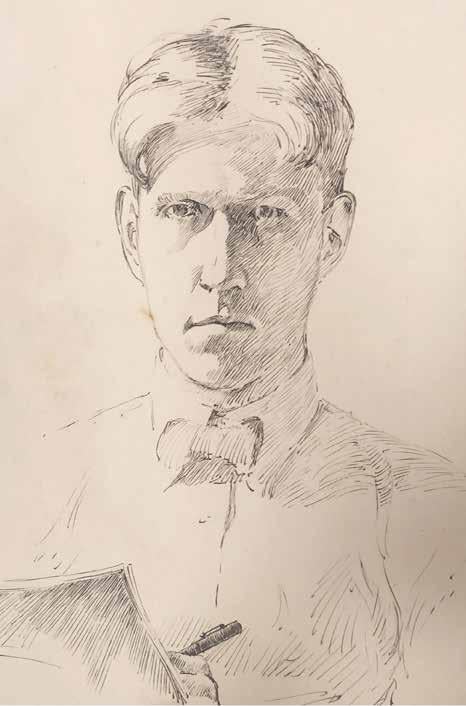
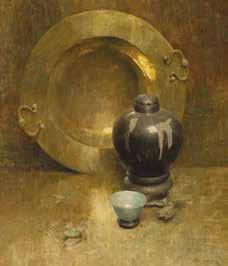


IN THE STUDIO | 25
CLOCKWISE FROM ABOVE
FIGURE 1 Dines Carlsen, The Jade Bowl, circa 1919, oil on canvas, Indianapolis Museum of Art at Newfields.
FIGURE 2 Emil and Dines Carlsen, 1931, Smithsonian American Art Museum, Archives of American Art, Emil Carlsen Family Photographs.
FIGURE 4 Johannes Vermeer, Young Woman with a Water Pitcher, circa 1662, oil on canvas, Metropolitan Museum of Art.
RIGHT Self Portrait; Pen in Hand, 1928–1966, pen and black ink on bond paper, 11x8.5 inches.

26 | NORDIC KULTUR
Innovation
Photo by Nikita Kachanovsky on Unsplash.
FACING PAGE
Robert Strand and Birger Steen record clips for the 2020 Virtual Nordic Innovation Summit. Norwegian Consul General Jo Sletbak takes a selfie while Robert Strand records.
THE WORLD NEEDS NORDIC INNOVATION
by Robert Strand, PhD, Executive Director of the Center for Responsible Business
WHAT IS THE PURPOSE OF INNOVATION? I asked myself this question a lot in advance of 2020’s Nordic Innovation Summit last May. I’ll return to this question.
I have dedicated my professional life to understanding Nordic global leadership in sustainability and building resilient societies—and what lessons America can draw from these Nordic experiences. Barbro Osher, the Swedish Consul General in San Francisco, gave me the nickname “Mr. Nordic,” so when I was invited to emcee 2020’s annual Nordic Innovation Summit alongside Birger Steen, Mr. Nordic happily accepted.
Though held virtually due to COVID-19, the Nordic Innovation Summit 2020 presented by Ericsson successfully brought together innovation leaders from the Nordic region, the Pacific Northwest and beyond
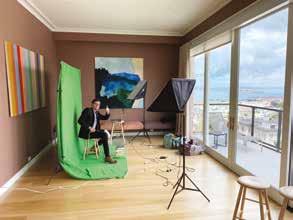
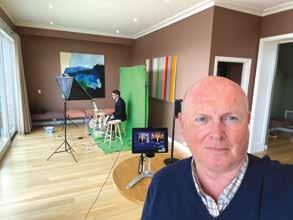
to share insights, build new relationships, explore opportunities for collaboration, and inspire new ways of thinking. Founded in 2018 –by the Museum with the support of Steen, a principal at Summit Equity and Museum Trustee, the summit has flourished since.
Built around four core Nordic values of openness, social justice, connection to nature, and innovation, the National Nordic Museum is the natural home for the Nordic Innovation Summit. The Nordic value of innovation is of course a focus for the summit: but when we talk about Nordic innovation, we are inherently also talking about innovation with the other values. Nordic innovation is about making the world a more just and sustainable place. Nordic innovation is about tackling the world’s most pressing challenges.
So back to that question: WHAT IS THE PURPOSE OF INNOVATION? As we entered the 2020 Nordic Innovation Summit amidst a global pandemic, heightened social unrest, and rising global temperatures, it became clear to me that the purpose of innovation is to meet real needs of the world. It simply has to be. Anything else would be a colossal waste of precious time and talent.
And this is precisely what Nordic innovation does. Nordic innovation meets real needs of the world.
As we kicked off the summit, I shared a story about Nordic innovation meeting real needs that is most relevant in these challenging times. Just before the summit, The Atlantic ran an article titled “The Doc-
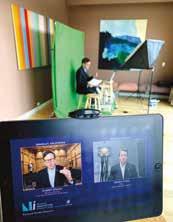
tor Who Had to Innovate or Else.” That doctor was Danish physician Bjørn Ibsen. Bjørn Ibsen’s innovation—a new way to use positive pressure to save polio patients in the 1950s—was born out of a real need. At that time, negative pressure ventilation was used for polio patients to breathe—a procedure which required use of the iron lung, a device invented in the 1920s. In the 1950s, when polio was one of the most serious communicable childhood diseases, the entire country of Denmark had only a single iron lung. Without iron lungs at his disposal, Ibsen innovated a new practice, involving hand pumping ventilators and using positive pressure, that would come to save hundreds of lives in Denmark.
Drawing from Ibsen’s learnings, the Swedish company Engström invented a machine that pumped ventilations mechanically the following year. That machine is the basis for the modern ventilator. Ventilators used around the world to save lives today—from COVID-19 and other diseases—are built upon this Nordic innovation. A real need driving innovation. That’s Nordic innovation.
When we talk about the real needs of the world, we are also inherently talking about the increasingly urgent need to address our world’s greatest sustainability challenges. This brings us back to the Nordics, as the very definition of sustainability has deep Nordic roots. Former Norwegian Prime Minister Gro Harlem Brundtland chaired the Brundtland Commission, which generated the timeless definition
THE WORLD NEEDS NORDIC INNOVATION | 27
of sustainable development that we know and still use today: sustainable development is “development that meets the needs of the present without compromising the ability of future generations to meet their own needs.”
Launched in 2015, the United Nations’ Sustainable Development Goals—or SDGs—serve as a globally-recognized framework that brings together the world’s most pressing challenges. Reduced Inequalities, Good Health and Well-Being, No Poverty, Climate Action, Clean Water and Sanitation, Zero Hunger, Gender Equality, Quality Education, and Affordable and Clean Energy are a few of the seventeen SDGs.

Nordic innovation tackles SDGs head on. It’s therefore unsurprising that the Nordics are global SDG leaders who regularly dominate the annual SDG Index. Sweden, Denmark, and Finland topped the
most recent 2020 index, and Nordic countries have routinely taken the top three places since the index’s inception in 2015.
This is not to say that Nordic work is done. The young Swedish activist Greta Thunberg reminds us that when it comes to urgent challenges like climate change and overconsumption, the whole world needs rapid improvement, including the Nordics. But a Nordic approach rooted in the Nordic values of openness, social justice, connection to nature, and innovation to meet real needs of the world represents our best hope to effectively address our greatest global challenges.
In my upcoming book, Sustainable Vikings: What the Nordics Can Teach Us about Reimagining American Capitalism, I begin with the bold statement “I believe the Nordics can save the world.” I truly believe this. But this is not meant as convenient praise: I offer this as a call to duty.
The world needs leadership. The world needs inspiration. The world needs hope and proof that societal, environmental, and economic well-being can go hand in hand.
The world needs Nordic innovation. And, fortunately, the annual Nordic Innovation Summit brings Nordic innovation to the world.
Dr. Robert Strand is Executive Director of the Center for Responsible Business and member of the faculty at the University of California, Berkeley, Haas School of Business. He also holds the title of Associate Professor with the Copenhagen Business School in Denmark and is a former US Fulbright Scholar to Norway. His upcoming book Sustainable Vikings: What the Nordics Can Teach Us about Reimagining American Capitalism will be published in 2022. Care to help with his efforts to launch a Nordic Center at the University of California, Berkeley? He can be reached at MrNordic@berkeley.edu (yes, that is his actual email address).
September 8–10
nordicmuseum.org/innovation
28 | NORDIC KULTUR
Photo by Oakie on Unsplash.
VOLUNTEER SPOTLIGHT
by Timothy Krumland, Volunteer Coordinator


The National Nordic Museum is privileged to rely on a wide range of volunteers for their support, time, and expertise. For this issue of Nordic Kultur, a few of our volunteers shared their thoughts and experiences on volunteering with us.
JACK HARMON-DAVIS , 17 years old, volunteer since mid-2018

What sparked your interest in volunteering with the National Nordic Museum?
My family had recently begun to talk more about our homeland (Finland and Sweden.) It made me naturally curious about my heritage, and it was the original inspiration to work for the Museum.
What is your favorite way to volunteer?
I work front desk normally, but to me my favorite work was done in the offices. Upstairs I would handle mail and outgoing volunteer forms, raffle and auction papers, et cetera. Also, working with the volunteer database had me rapidly get used to technology I had very little previous experience with.
What advice would you give to a new volunteer?
Engage with staff, get to know everyone. Everybody at the Museum has something to offer to your work experience.
KIM RUSSELL, 35 years old, volunteer since mid-2018 (visitor since 2016)
What sparked your interest in volunteering with the National Nordic Museum?
After moving to Seattle from Los Angeles where I completed an MA in Scandinavian Studies, I knew I wanted to stay connected to Nordic culture in some way. I also wanted to make connections with people and find community. I had one small kid at the time and wasn’t quite ready to start looking for work so I decided to volunteer my time when I could. I had previously worked at the American Swedish Historical Museum in Philadelphia and knew how much fun a cultural museum can be.
What is your favorite way to volunteer?
I love to volunteer in the Museum Store. I get to talk with visitors from all over the world about great Nordic design and culture. I had a fantastic time volunteering at the flower crown table during Nordic Sól in 2019. Visitors were excited to try their hand at making a flower crown, a typical Swedish Midsummer experience. It was a great example of a Scandinavian
custom that anyone can participate in, regardless of heritage. There is no one perfect way to make a flower crown!
What advice would you give to a new volunteer?
Have fun and dig in! Immerse yourself in the experience and make the museum your third place. It may be world class, but it is also a warm community! Volunteer during regular hours but also volunteer for events and lectures to see a different side of the Museum. Talk to visitors and tell them what you love about the Museum and about Seattle.
BRANDON BENSON ,
62 years old, volunteer since about 2005 (Member since late 1990s)
What sparked your interest in volunteering with the National Nordic Museum?
I found the Museum had many events and activities, and volunteering was an opportunity to be more involved with the organization.
What is your favorite way to volunteer?
I have taken on a wide variety of volunteer roles at the museum, though I find volunteering with the Nordic American Voices project to be very interesting and rewarding. A memorable volunteer experience would be an interview that Gordon Strand and I conducted for the Nordic American Voices project. Gordon and I interviewed Dane Jensen and focused on Dane’s experience designing and creating Danish furniture. The interview took place at the former Museum location, and at the time of the interview, the Museum had an exhibit that featured Danish furniture. Because the interview took place on a Monday, when the Museum was closed, we held the interview in the exhibit.
What advice would you give to a new volunteer?
I suggest that volunteers try new volunteer opportunities. I do not knit, but I volunteer at the registration table for the Knitting Conference that is held every two years.
Thank you to Jack, Kim, and Brandon for sharing your volunteer memories with us, and thank you to the thousands of wonderful volunteers we have been fortunate to work with over the past 41 years. If you are interested in volunteering for the Museum, please contact Timothy Krumland at timothyk@nordicmuseum.org
VOLUNTEER SPOTLIGHT | 29
Volunteer Spotlight
Timothy Krumland has worked for the National Nordic Museum in several capacities, most recently as the Volunteer Coordinator. He loves all things Swedish and soccer.
The Legacy of Norway’s First Bunad, The Nasjonaldrakt
by Carrie Hertz, PhD, Curator of Textiles and Dress at the Museum of International Folk Art
FOR RITES OF PASSAGE, public celebrations, and national holidays, a growing number of Norwegians wear bunader in a dazzling array of styles. This contemporary clothing is made in the likeness of preindustrial regional festive dress and worn as a marker of local and national identity. Proponents of the early twentieth-century bunad movement prioritized clothing’s symbolic potential to evoke the notions of place and a shared past.¹ Before the bunad, however, there was the Nasjonaldrakt (literally “National Costume”), a standardized form of clothing inspired by the dress of Hardanger, a district nestled around the Hardangerfjord in Hordaland county (now part of Vestland county). Of all the districts of Norway with characteristic folk costume, Hardanger became especially meaningful to how the nation was perceived at the end of the nineteenth century.
Between 1814 and 1905, Norway freed itself from Denmark, ratified a democratic constitution, and quickly lost its nascent independence to Sweden. Held in unequal union, Norwegians rallied around symbols of national resilience and distinction. To revolutionaries, the dramatic vistas of the western fjords and the beautiful dress of its proud farmers represented everything unspoiled and indomitable about Norway. Patriots championed the folkways of Hardanger as pure survivals heroically resisting modernization and foreign dominance. Farmers and their characteristic dress be-
came both symbols of the mythic past and the recipe for progress as quintessential Norwegian rebels.
At the turn of the twentieth century, women still wore locally-distinct styles of dress in Hardanger. In paintings, sketches, and photographs, European artists depicted the region’s resplendent folk dress against a backdrop of sparkling waterfalls, towering mountains, forests, and glaciers. Enticed by these thrilling images, tourists (both foreign and domestic) flocked to Hardanger.²
Tourism altered daily life throughout Hardanger, but nowhere more so than Odda, a tiny village perfectly situated at the end of the Sørfjord branch of the Hardangerfjord. By the 1890s, multiple cruise lines terminated at Odda, supporting new entrepreneurs who ferried visitors to nearby waterfalls, guided hikes and salmon fishing expeditions, sold handicrafts, and opened hotels, cafés, and souvenir shops.
Beyond the magnificent scenery, tourists hoped to see exotically-dressed women like the bride depicted in Hans Gude and Adolph Tidemand’s 1848 Brudeferd i Hardanger (Bridal Procession in Hardanger), perhaps the most famous painting to emerge from the era. The idealized and widely-shared images of Hardanger brides in their bejeweled crowns and red beaded bodices epitomized a glorious past and its innocence from worldly modern corruption. From his souvenir shop in Odda, Ole Theresius O. Ohm sold hand-painted
portraits of young women dressed as Hardanger brides.
Men’s appearance did not inflame the same romantic imagination. Hardanger men had mostly traded their distinctive dress for more cosmopolitan suits by the 1840s. Women’s dress, in contrast, included a variety of garments made in a wide assortment of fabrics, colors, and prints with embellishments of lace, ribbons, or the region’s characteristic cut-thread embroidery now widely known as Hardangersøm (Hardanger embroidery). Bodices had wide openings filled with removable inserts called bringklutar in local dialect. An easily changeable element, fashions for new bringklut designs came and went, rendered in various techniques, including weaving, pattern darning, beadwork, or embroidery. The focus on women, their bodies, and craft skills, presented novel opportunities for financial independence. Anna Persdotter Jordal opened a dress shop in Odda where she sold simplified versions of Hardanger dress to tourists.³ Tourist versions borrowed the look of one formal style common to the Sørfjord area. Increasingly considered Norway’s national costume, this outfit invariably included a red bodice and dark skirt, paired with a white apron decorated with Hardangersøm. The
30 | NORDIC KULTUR
Heritage
FACING PAGE : Synnøve Kvamme (center), with sisters Halldis and Gudrun Folkedal, dressed in Hardangerbunader.
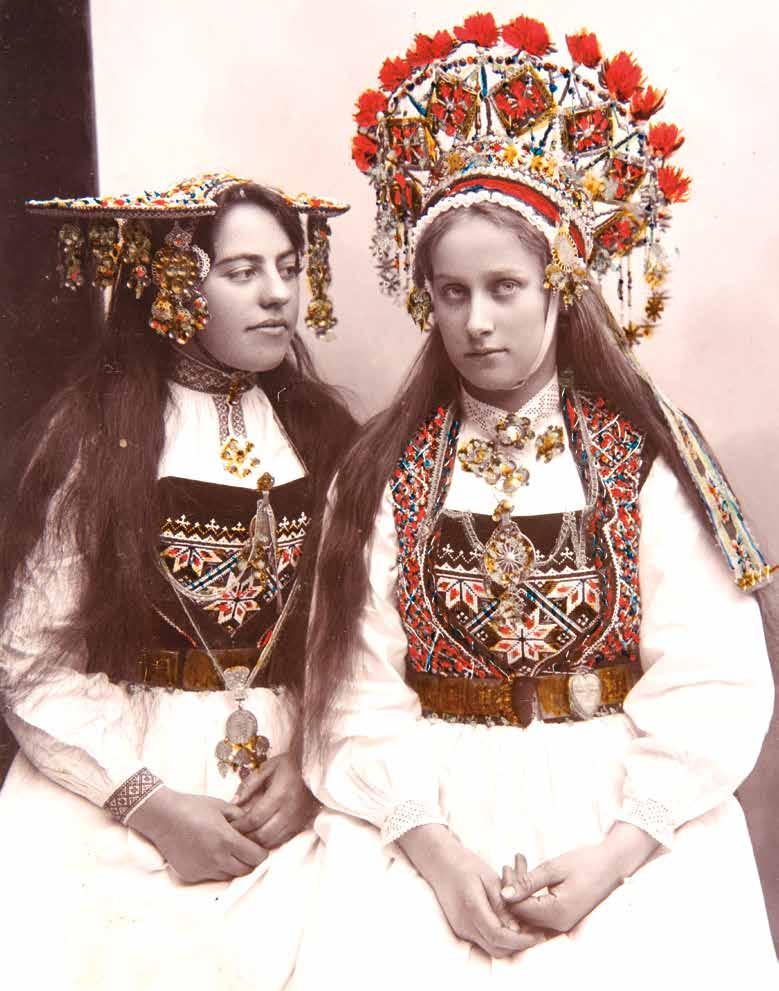

THE LEGACY OF NORWAY’S FIRST BUNAD, THE NASJONALDRAKT | 31 © Jan M. Lillebø
bringklut was always beaded, usually in an eight-pointed star or rose pattern. This combination of striking heraldic colors may have been favored for resembling the Norwegian flag.⁴ It also closely matched the combination worn by Hardanger brides.
By the end of the nineteenth century, these standardized outfits were adopted and adapted by political agitators demanding national sovereignty. Those who wore Hardanger clothes as national costumes often rejected the cumbersome skaut (headdress) identifying married women, choosing instead the small, beaded caps worn by unwed girls. The Nasjonaldrakt became a common sight at political demonstrations, public gatherings, youth meetings, and folkdance performances.
Today, Hardanger dress remains diverse and meaningful within local experience, now more often called the Hardangerbunad. As elsewhere in Norway, a Hardanger girl typically receives her first bunad for church confirmation in her teens.
Marit Bleie Mannsåker of Ullensvang has fond memories of receiving bunad. Her mother spent years assembling the necessary pieces. “I knew what drawer my stuff was kept in,” she says. “I always wanted to look at it and touch it.” The anticipation of wearing beautiful garments for the first time was a joyful rite of passage. Mannsåker is now making bunader for her two granddaughters. “Girls today,” she says, “they are so proud to wear it.” Mannsåker believes the self-esteem girls derive from their first bunad comes, in part, from feeling loved and cared for by others. What she values most about local dress traditions is that they “strengthen family connections.” For this reason, she disapproves of political uses of Hardangerbunad.
When Mannsåker was growing up, Hardanger dress was still widely known as Nasjonaldrakt. In Mannsåker’s recollection, her teachers discouraged children from calling it that, saying “No, it’s our bunad. It belongs to this area.” By the 1960s, the broader term disappeared from local speech, but the gaps between provincial experience and national imaginaries persist.
Agnete Sivertsen, curator at the Hardanger Folkemuseum in Utne, feels that the Hardangerbunad still has nationalist connotations today. However, Sivertsen gives examples of locals using bunad to protest the Norwegian state interfering
in provincial affairs. One protest, begun in 2010, failed to prevent construction of high-tension power lines. To activists, this expensive—and possibly unnecessary— modernization would not only harm local tourism and the environment, but the proposed benefits would primarily profit urban populations and transnational corporations. During protests, environmentalist Synnøve Kvamme was arrested for occupying a building site. Photographs of police lowering her from a shipping container dressed in Hardangerbunad, her arms outstretched like a crucified messiah, went viral.⁵ The powerful imagery activates the long history of using Hardanger’s landscape and dress to evoke feelings of patriotism, yet reframes it as a repatriation of local resources by provincial rebels.
Sivertsen explains that Hardanger dress has been politicized for centuries, “used by people far left and far right and in between. Everybody uses it.” Increasingly, some locals equate nationalistic uses of Hardanger dress to the state government’s exploitation of provincial resources at the expense of rural communities.
Even before Hardanger’s tourist industry was decimated by World War I, premier destination Odda was transformed by foreign investment into private industry. At the turn of the twentieth century, British industrialists and energy speculators bought up water rights for hydroelectric power. Chemical plants, refineries, factories, and smelting operations sprang up, enabled by a new Tyssedal Hydroelectric Power Station. As smoke and odorous chemical emissions choked the air, run-off endangered salmon, and dams dried up waterfalls, tourists stopped visiting and many multigenerational families packed up for the US.
Advantages came with industry. For much of the twentieth century, Odda had well-paying jobs, excellent schools, hospitals, libraries, and municipal swimming pools. Most companies, however, have since moved or declared bankruptcy, citing the pressures of globalization, leaving thousands unemployed. Especially embittering to some, the landscape, once the main resource for livelihoods, is no longer viable for fishing, farming, or tourism.⁶ While other areas of Hardanger enjoy renewed success with the growing popularity of Hardangervidda National
Bringklutar from Hordaland county, Museum of International Folk Art, gift of Florence Dibell Bartlett (A.1955.1.533, 450, and 538).
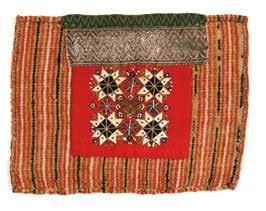
FACING PAGE
TOP Bringklutar from Hordaland county, Museum of International Folk Art, gift of Florence Dibell Bartlett (A.1955.1.534).
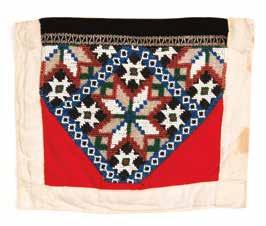
CENTER Bringklut for Nasjonaldrakt, by Anna Persdotter Jordal, ca. 1900, Museum of International Folk Art, gift of the Friends of Folk Art (A.2017.64.15).

BOTTOM Hand-painted souvenir photograph of models dressed as brides from Hardanger and Voss, by Ole Theresius Ohm, ca. 1900, Museum of International Folk Art, gift of Kraftmuseet—Norsk vasskraft-og industristadmuseum (A.2019.41.1).
PAGE 34
32 | NORDIC KULTUR
Anna Persdotter Jordal in the doorway of her dragthandel in Odda, ca. 1900.
Photo by Addison Doty.
Photo by Addison Doty.
Photo by Addison Doty.
Park and Trolltunga rock formation, Odda lags behind. Travel franchise Lonely Planet deemed Odda “Norway’s ugliest town.”⁷
Some residents now advocate for a tourism renaissance by incorporating “industrial heritage” into an attractive cultural history. In 2000, the former Tyssedal power station became an historic landmark managed by Kraftmuseet (The Norwegian Museum of Hydropower and Industry). The museum’s orientation video quotes twentieth century engineer Harald Hansen: “We have the waterfalls. We have the white coal . . . Our falls are beautiful to behold. This is true. In one sense, they’re lost, but in another, the falls are resurrected with a thousand times more beauty, as they give our country richness and greatness.” In other words, the natural resources of Hardanger, like the symbolism of its folk culture, supported Norway’s development into a thriving modern nation. This can be a compelling narrative for many in Odda today, especially those who grew up during the 1960s boom years.
Randi Bårtvedt, the first Director of Kraftmuseet and now Director of the Hardanger og Voss Museum system, describes her childhood in Odda as idyllic: “We had the best of everything growing up. I’m proud of the industry here. It created a good life for a hundred years.” When Bårtvedt attended university in Bergen, however, she discovered that people from Odda “were looked down upon.” “Sometimes,” she explained, “it feels we’re not a part of Norway. Everything is in foreign hands.”
Through the lens of romantic nationalism, Odda was the epicenter of everything “purely Norwegian.” That contrast—being viewed today as a symbol of globalization’s failures—is disturbing. Odda’s transformation has left many unable to satisfyingly define themselves and the character of their community.⁸ Which history should Odda’s inhabitants preserve and revere for future generations—the wild lands, provincial culture, or technological innovations of Norway’s industrialization? Bårtvedt, despite fierce opposition, believes we should remember all these interwoven pasts.
At the grand opening of Kraftmuseet, Bårtvedt wore her Hardangerbunad, proud that it represents the endurance of local tradition despite ongoing cultural, economic, and environmental change. Local dress persists as a vehicle for female
industry, providing an outlet for self-expression, social influence, and financial gain. Though beautifully dressed women symbolized the region during romantic nationalism, Odda’s industrial modernity celebrated masculine dominance. But at the opening, Bårtvedt, a woman in traditional dress, now stood empowered to interpret that industrial past. Some locals were displeased to see Hardangerbunad in this context. The values embodied in folk costume and the relics of industrialization felt incompatible to them, perhaps disrespectful. Like Odda itself, Bårtvedt argues, “I embody many contradictions.”
Bårtvedt grew up in a family employed by local industry, and she grew up wearing Hardangerbunad. Her mother, in fact, was recognized for developing a novel way to weave bringklutar. To Randi, the dress and factories are not opposing facets of Odda’s history: they are integrated features of her lived experience.

In popular consciousness, regional dress remains entwined with cultural tourism and a romanticized view of provincial land, but Hardanger dress existed before the region was “discovered” by romantic nationalists and lives on in the context of post-industrialization. As Bårtvedt illustrates, the layering of associations can be contradictory, juxtaposing rhetorical opposites, like folk and modern. Choosing which aspects to prioritize and celebrate in one’s life becomes an expression of values. Marit Bleie Mannsåker, for example, characterizes the Hardangerbunad as a manifestation of social and familial nurturing. From this perspective, thriving traditions for local dress suggest healthy relationships between kin and neighbors. It suggests healthy communities. For those in Hardanger who feel abandoned by industry, for those who believe state-owned power companies act in bad faith, for those who sense smug entitlement from urban elites, these situations imply a breakdown in community and exacerbate the sense that outsiders do not care about the wellbeing of local people or their environment. Like tourists and prospectors, they take what they can and move on.

When Agnete Sivertsen connected the national character of Hardangerbunad with examples of provincial protests, she made an important point. By protesting in Hardangerbunader, locals not only wish to agitate for more local control, they also

THE LEGACY OF NORWAY’S FIRST BUNAD, THE NASJONALDRAKT | 33
Photo by Addison Doty.
Photo by Addison Doty.
Photo by Addison Doty.
hope to conjure up the romantic-national history of Nasjonaldrakt to inspire Norwegians across the country to consider themselves mutually responsible: when one region is polluted and overruled, it damages the imagined whole.
The fight for Norwegian independence and the development of the welfare state after World War II were both justified by championing universal principles of unity in diversity, equality, and social security. For many citizens, in Hardanger and beyond, wearing bunad articulates hope that Norway will live up to these principles.
More recently, women in bunader of all kinds have taken to the streets to protest the closure of rural maternity centers, compelling pregnant women and mothers with newborns to travel far distances. Calling themselves Bunadsgeriljaen (bunad guerillas), one protestor explained that because bunader is widely associated with family tradition, healthy lineages, and “warm thoughts about our own country,” they can “become a symbol of the battle for what kind of health and welfare services we want to keep for the future.”⁹
Just as the Nasjonaldrakt helped Norwegians envision the nation of their dreams more than a century ago, as bunader, regional dress remains a persuasive medium for understanding the past and advocating for thriving futures.

ACKNOWLEDGEMENTS
I am deeply grateful to Brita Jordal, Marit Bleie Mannsåker, Randi Bårtvedt, Agnete Sivertsen, and others in Hardanger for graciously sharing their time and expertise. I also offer thanks to Camilla Rossing for making introductions and assisting with translation. Håkon Brattespe, archivist
at the Hardanger Folkemuseum, kindly introduced me to Kolltveit’s invaluable local history. Research was made possible with funding from the International Folk Art Foundation and Museum of New Mexico Foundation.
¹ Ylvisåker, Anne Britt. “Folk Costume as a National Symbol.” In Crowns and Roses: The Living Tradition of Norwegian National Costume, edited by Magny Karlberg and Anne Britt Ylvisåker. Utenriksdepartementet (Norwegian Ministry of Foreign Affairs), 1999.
² Barton, H. Arnold. “The Discovery of Norway Abroad, 1760–1905.” Scandinavian Studies 79, no. 1 (2007): 25–40.
³ Kolltveit, Olav. Odda, Ullensvang og Kinsarvik: i gamal og ny tid. Vol II. Translated by Hans H. Coucheron-Aamot. Odda, Ullensvang og Kinsarvik Bygdeboknemnd, 2005 [1962]; See Kolltveit, Odda, Ullensvang og Kinsarvik, 213; Bårtvedt, Randi, and Axel Mykleby. “The Tourists, the Landscape and the Fantasy Hotels,” Grind. Universitetet i Bergen, May 19, 2009. https://www.grind.no/en/ animal-life/tourists-landscape-and-fantasy-hotels.; and Ylvisåker, 301-302.
⁴ Colburn, Carol Huset. “Norwegian Folk Dress in America.” In Norwegian Folk Art: Migration of a Tradition, edited by Marion Nelson, 157–170. New York: Abbeville Press, 1995.

⁵ A 2016 documentary by Hardanger filmmaker Vigdis Nielsen, Kampen om fjordane (Fight for the Fjords), details the controversy.
⁶ Eitrheim, Karsten, Endre Skaar, and Nils George Brekke. “Odda: The Industrial Town.” Grind. Universitetet i Bergen, June 9, 2015. https://www.grind.no/en/hardanger/ odda/oddaindustrial-town.
⁷ Torpey, Paul. “Industrial Revolution,” The Guardian, October 3, 2007. https://www.theguardian.com/travel/2007/ oct/03/norway.heritage.
⁸ Cruickshank, Jørn, Winfried Ellingsen, and Knut Hidle. “A Crisis of Definition: Culture versus Industry in Odda, Norway,” Geografiska Annaler: Series B. Swedish Society for Anthropology and Geography, 2013.

⁹ Berglund, Nina. “Bunads Turn into New Battle Gear,” News in English: Views and News from Norway, May 2, 2019. https://www.newsinenglish.no/2019/05/02/bunadsturn-into-new-battle-gear/. “National Costume: A Symbol of Norwegian Identity.” In Heritage and Museums: Shaping National Identity, edited by J.M. Fladmark, 299–309. Dorset, UK: Donhead, 2000.
Carrie Hertz is Curator of Textiles and Dress at the Museum of International Folk Art. She earned her MA in Museum Studies and her PhD in Folklore from Indiana University. Her work explores the social, cultural, aesthetic, ethical, and political dimensions of dress. Her most recent project is Dressing with Purpose: Belonging and Resistance in Scandinavia, an exhibition and forthcoming publication from Indiana University Press.
The National Nordic Museum’s Norwegian American Emigrant Bunad (1989) will be on loan to the Museum of International Folk Art for its special exhibition Dressing with Purpose: Belonging and Resistance in Scandinavia. The garment bears Norwegian and American flags and the motif of a Viking ship, recalling the voyage of Norse explorers to North America. Referencing the longstanding bond between the continents, Kathe Nilsen of Olso designed and sewed the bunad. Upon a visit to the Pacific Northwest, she presented it to Ballard’s Leif Erikson Lodge No. 1. In 2004, the lodge gifted the bunad to the National Nordic Museum.
Bunad from the Museum’s Collection on Loan
34 | NORDIC KULTUR
Courtesy of Kraftmuseet—Norsk vasskraft-og industristadmuseum.
A Common Thread
Icelandic embroidery series, history, and refilsaumur
 by Rosemary Jones, Marketing Director
by Rosemary Jones, Marketing Director
IN 2020, Museum staff produced more than one hundred hours of digital programming that could be experienced anywhere in the world. One such project was a series on Icelandic embroidery created by Claudia Pétursson, handwork expert and ambassador for the Njál’s Saga Tapestry Centre in Hvolsvöllur, Iceland.
Originally scheduled to teach in person at the Museum, Pétursson responded to the new COVID-19 restrictions by starring in a fascinating video series that wove together teachings on traditional Icelandic embroidery, the Njál’s Saga project, and crafting at home. The videos debuted on the Museum’s YouTube channel in May 2020.
In the first video, Pétursson introduces viewers to the Njálurefill or the Saga of Njáll Tapestry. Begun in 2013, this modern-day tapestry is the ultimate crowd-sourced project. Visitors to the Tapestry Centre in Hvolsvöllur are invited to take a stitch or
several to help the saga unfold. The finished work is planned to be approximately 295 feet in length (90 meters).
Designed by Kristín Ragna Gunnarsdóttir, the tapestry follows the adventures of the warrior Gunnar of Hlíðarendi and the sage/lawyer Njáll of Bergþórshvoll. The thirteenth-century Icelandic saga is considered one of the classics of world literature. Stitched on linen, the twenty-first century tapestry uses the embroidery styles of the Northern European medieval period to tell the ancient story.
The scenes are created with colorful yarns spun from Icelandic wool and dyed with pigments extracted from local plants—typical of the materials used in the period of the sagas. Employing the embroidery style called refilsaumur, the volunteers’ stitchwork is similar to the type of laid work that was created in the time of the saga. This type of embroidery can be seen in the famous eleventh-century Bayeux
Tapestry, which served as an inspiration for the Icelandic project.

Embroidery enthusiasts can fashion their own small artworks at home in refilsaumur using kits created by the Tapestry Centre or their own materials. Embroiderers can follow along with Pétursson’s free videos to learn how to achieve beautiful results and enjoy a little Icelandic history while they perfect their anchor stitch.
Pétursson’s videos can be found at youtube.org/ nordicmuseum along with other Museum programming. Icelandic embroidery kits from the Njál’s Saga Tapestry Centre are available in the “Nordic Crafts” section of nordicmuseum.org/ museumstore.
Rosemary Jones is the Director of Marketing for the National Nordic Museum. Her many nonfiction articles have appeared in magazines, newspapers, and online. An award-winning author of science fiction and fantasy, her most recent novel Mask of Silver was published in 2021 by Aconyte.
Heritage
A COMMON THREAD | 35
The United States of Nordic America
The National Nordic Museum is located in the Ballard community of Seattle, Washington—a traditionally Nordic neighborhood. But there are Nordic gems throughout the US— areas where Nordic immigrants made their mark on the local landscape in historic, artistic, and sometimes downright fun ways. Here are a few Nordic American places we think you’ll enjoy learning about.*
ALABAMA
1 Thorsby Swedish Fest
Thorsby, Alabama
Settled in 1865 by three Swedes and a Norwegian, Thorsby is proud to be a “Scandinavian Colony in the South.” Architecture throughout the city displays Thorsby’s Nordic roots, and the town celebrates every October with huge festival (including a Viking-themed 5K race) to celebrate the founding families’ heritage.
ALASKA
2 Bering Strait, Island, and Sea

Northern Pacific Ocean
Danish navigator Vitus Jonassen Bering (b. 1681, Horsens, Denmark–d. 1741, Bering Island) was a navigator in the Russian service. He was the first European to explore Alaska and the Bering Strait region. He has a strait, island, and sea named after him.
DELAWARE
3 Finnish Embassy Sauna
Washington, D.C.
“If liquor, tar and sauna don’t help . . . it’s fatal.” —Finnish proverb
Each Finnish Embassy in the world has its own sauna! Good luck getting an invitation to the private Diplomatic Sauna Society, though—we hear it’s the hottest ticket in town!
MICHIGAN
4 Trenary Toast
Trenary, Michigan
Trenary Toast has been serving up twicebaked Finnish coffee bread known as Trenary Toast since 1928. With a recipe that’s still going strong after ninety years, it’s easy to see why this treat is the toast of the town.
MINNESOTA
5 Karl Oskar and Kristina Statue
Lindstrom, Minnesota
In the 1950s, Swedish author Vilhelm Moberg immortalized the experiences of Minnesota’s early Swedish settlers with his series of novels, collectively known as The Emigrants. Protagonists Karl Oskar and Kristina are immortalized in a stone statue in Lindstrom. The town also hosts an annual Karl Oskar Days festival.
6 Hjemkomst Center
Morehead, Minnesota
The Historical and Cultural Society of Clay County, operating out of the unique, tentlike Hjemkomst Center, also oversees the The Hopperstad Stave Church replica and The Hjemkomst Viking Ship.
*What’s your favorite Nordic gem in America?
Let us know at marketing@nordicmuseum.org for possible inclusion in our next issue’s map!
MONTANA
7 Helsinki Bar and Steam Bath
Butte, Montana
In the 1920s, “Finn Town” was a lively section filled with miners of all nationalities. Completed in 1911, the town’s Finnish sauna connected Finnish miners with their roots for a quarter a steam. The building still stands today.
NEBRASKA
8 St. Peder’s Dansk
Evangelical Lutheran Church
Nysted, Nebraska
Built in 1919, St. Peder’s is now on the National Register of Historic Places. It is one of the few structures in America to feature the square entrance tower and stepped gables of fifteenth and sixteenth century Danish church architecture. Nysted’s population peaked in 1890 at sixty-five residents.
9 Wausa Community Swedish Smörgåsbord


Wausa, Nebraska
Every fourth Saturday in October, the town of Wausa (a combination of “Vasa” and “USA”) puts the more in smörgåsbord! This festival serves up many traditional Swedish bites and hosts one of the country’s largest smorgasbord.
36 | NORDIC
KULTUR
13 10 2
10 Svensen & Svensen Island
Astoria, Oregon
Svensen and Svensen Island are unincorporated communities outside of Astoria named for Peter Svensen, a Swedish pioneer who settled there in the 1850s.

PENNSYLVANIA
11 Old Swedish Burial Ground

Chester, Pennsylvania
A heritage cemetery, Old Swedish Burial Ground is the final resting place to one of America’s Founding Fathers. Born to Finnish and Swedish parents, John Morton (1724–77) was influential in getting Pennsylvania to vote in favor of the Declaration of Independence. He also contributed to writing the Articles of Confederation.
12
Danevang, Texas
Built to resemble a Danish barn, The Danish Heritage Museum of Danevang is a unique, 6,100 square-foot structure that tells more than 100 years of Danish emigration history. Danevang is considered the “Danish capital of Texas.”


WASHINGTON
13 Trinity Community

Lutheran Church
Point Roberts, Washington

The congregation, founded by Icelandic pioneers, finished construction on their church in 1920.



14 Little Finland

Hurley, Wisconsin
Known as Little Finland, The National Finnish American Festival (NFAF) Cultural Center preserves and shares the Finnish history and culture of the area’s early miners. The center includes several historic houses and a sauna.

ATLANTIC
15 US Virgin Islands
Caribbean Sea
Originally colonized in the seventeenth century by Denmark, the Danish West Indies were sold to the United States by Denmark in 1917 for $25 million in gold. Saint Thomas, Saint John, and Saint Croix are now known as the US Virgin Islands.

THE UNITED STATES OF NORDIC AMERICA | 37
OREGON
TEXAS
Danish Heritage Museum of Danevang
WISCONSIN
OCEAN
15 14 12 11 9 8 7 6 5 4 3 1
Freezing for the Future
Diverse crop conservation at the Svalbard Seed Vault
 by Becky Forsberg, Guest Services Manager
by Becky Forsberg, Guest Services Manager
A SCANT SIXTY MILES FROM THE NORTH POLE lies the Svalbard archipelago in northern Norway. The area is best known for its large population of Svalbard polar bears, with approximately 270 bears in the area. With its solid ice shields, deep centuries-old permafrost, and minimal human development, the environment of this arctic region is ideal for species like polar bears to thrive. It is also an ideal spot for a deep freezer full of important seed specimens.
Nestled almost 400 feet (120 meters) into the Arctic permafrost sits more than one million seeds. The seeds are stored in the Svalbard Global Seed Vault, a protective seed archive owned by Norway. The vault is operated by NordGen, a genebank supervised by the Nordic Council of Ministers. Genebanks promote and conserve sustainable genetic resources of plants—especially of those important to food and agriculture. In partnership with the Norwegian Ministry of Food and Agriculture and Crop Trust (an independent international food sustainability organization), the Svalbard vault is the Nordic region’s answer to crop diversity and
food security. Around the world, most seed banks face challenges with cost, climate change, wars, and political opposition, making it hard to maintain sustainable preservation of their seed samples. The Svalbard vault—occasionally nicknamed the “Doomsday” vault—was built to address those challenges while still providing a protected, large-scale backup facility for seed storage.
There are over 1,700 genebanks in the world; the Svalbard facility is the largest genebank, with the ability to store over 500 million seeds. Built in 2008 for approximately $9 million US (81 million kroner), the vault is designed as an impenetrable, extremely cold freezer that uses the surrounding permafrost to regulate an internal temperature of -0.4°F (-18°C). The facility is run primarily through natural or environmental factors, which requires little interference by humans. In fact, the only task that requires staff help is the actual depositing of seeds into the vault chambers. While the high security of the vault was its major draw as the world’s backup facility, the surrounding environmental factors made it seem flawless.

38 | NORDIC KULTUR
Sustainability
Photo by NordGen.


THE SVALBARD SEED VAULT | 39
However, climate change in the Arctic region has created a flaw: rising temperatures are making basic vault maintenance difficult. In 2019, the Greenland ice sheet lost a record-breaking 586 billion tons (532 billion metric tons) of ice, adding 0.06 inches to global sea levels. In July 2020, Svalbard recorded its highest temperature in history at 71°F (21.6°C). While the polar bear population in Svalbard is unaffected by these threats for now, the same cannot be said about the permafrost. In October 2016, higher-than-average temperatures and heavy rain fall caused water to flood the main entrance of the vault and freeze overnight. Fortunately, after chipping away the ice, workers found that the water did not reach to the seed chambers. Unfortunately, these unexpected climate issues resulted in additional costs to vault maintenance. In 2018, the Norwegian Ministry of Food and Agriculture approved $21.9 million US (over 200 million kroner) to upgrade the facility with drainage pipes, additional access tunnels, and more refrigeration equipment—necessary upgrades as the Arctic prepares for a much warmer and wetter future.

These upgrades provide stronger protection from environmental threats at an important time. Temperatures are slowly rising in the arctic circle. A 2019 report, Climate in Svalbard 2100, shows that the average temperature for Svalbard rose by 5.4°F (4°C) in the past fifty years, and will likely rise another 15°F (10°C) by 2100. Rainfall is projected to increase by 45–65 percent in that same timeframe. As Ellen Hambro, Director of the Norwegian Environment Agency said, “It is rare that I use words like this, but what is happening in Svalbard is
extreme. The temperature is rising faster here in the Arctic than anywhere else in the world, and climate change has already had major consequences for nature, animals, and the community on the island group.”
Though the unpredictable changes in the permafrost will continue to present challenges to NordGen’s Svalbard Global Seed Vault, the quick response to update the facility after the 2016 emergency shows a commitment to keeping the vault as secure as possible. Fortunately, climate problems have not negatively impacted the importance of the vault; to the contrary, they underscore the importance of such a backup. Deposits from many different countries, regions, and cultures continue to come in. Perhaps one of the more significant achievements for sustainability is preserving seeds from marginalized cultures. In February 2020, the Cherokee Nation became the first Indigenous tribe from the United States to deposit seeds, a total of nine ancient heirloom species in all. As Cherokee Nation Principal Chief, Chuck Hoskin Jr. said, “This is history in the making.” The Cherokee Nation is joining other Indigenous groups, like the Peruvian descendants of the Incas who deposited ancient potato seeds in 2017 in preserving their cultural resources for future generations.
Preserving such important cultural history amidst the threat of climate change is a daunting task, but certainly a rewarding one. The importance of the Svalbard Global Seed Vault as the “final back up” for worldwide crop diversity cannot be underestimated.

classes in traditional crafts

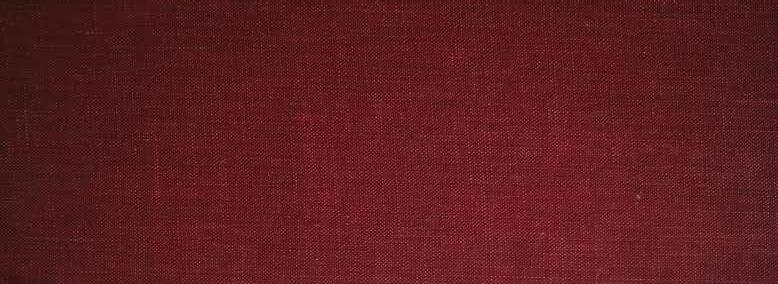
Through talks and demonstrations, this summer-long series of mini-classes will introduce you to a variety of traditional Nordic crafts, including rosemaling, dalmalning, woodcarving, knitting, and weaving
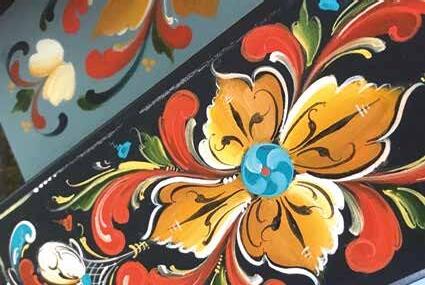
nordicmuseum.org/calendar
Virtual Folk School 2021
Becky Forsberg is the Guest Services Manager for the National Nordic Museum. She likes to spend her free time researching new ideas for reducing the human impact on our environment while listening to a lot of Bob Dylan.
40 | NORDIC KULTUR
UPPER A case of newly archived seeds ready to be stored.
LOWER A Seed Vault worker situates a row of specialized seed crates in the vault.
PREVIOUS SPREAD The outside of the Svalbard Seed Vault, February 2020.
Photos by NordGen.
Rosemaling by Lise Lorentzen.
Scan Design Foundation
A decade of support and a lifetime of impact
 by Erik Pihl, Director of Development
by Erik Pihl, Director of Development
In December 2010, Scan Design Foundation made an extraordinary commitment of $3 million to the National Nordic Museum; at that time, it was the largest commitment by a foundation to the Museum. Of that, $2 million was to be used for the Museum’s capital campaign for the new Museum and $1 million was to support Danish and Danish-American programs over the next twenty years. National Nordic Museum Executive Director and CEO Eric Nelson remembers his conversations with Scan Design Foundation President Emeritus, Mark Schleck. “Scan Design Foundation’s support really jumpstarted the capital campaign for the Museum as it is today,” says Nelson. “With a two-decade commitment of support, we have been able to develop excellent Danish programs and have brought exceptional exhibitions to Seattle such as 2019’s On the Edge of the World: Masterworks by Laurits Anderson Ring from SMK the National Gallery of Denmark.”
Established in 2002, the Scan Design Foundation is the legacy of Danish immigrants Inger and Jens Bruun. Both grew up in rural areas of Denmark; Jens on a farm in Jutland and Inger in Andst. After marrying in Denmark, they immigrated first to Canada, then to the US. In 1964, they opened their first Scan|Design Furniture store in Bellevue, featuring high-quality Danish-made modern furniture. Scan|Design Furniture became a thriving business, eventually expanding to eight stores in Washington, Oregon, and Hawaii. Jens and Inger were proud of their Danish heritage

and wanted to provide an opportunity for other Danish citizens to learn about America. Beginning in the early 1970s, each year Jens and Inger invited four interns from Denmark to live with them in America and work at Scan|Design Furniture. Over the course of three decades, more than 147 individuals worked as interns with Jens and were fully embraced into the Bruun family.
Sadly, Inger passed away in 1987. Before his own death in 2002, Jens created the Scan Design Foundation to foster and support Danish-American relations as well as further pain research—an area in which he had developed an interest during his later years. According to Mark Schleck, the Foundation “opened a new chapter in the legacy of Jens and Inger Bruun.” Schleck retired in 2020 and was succeeded by Fidelma McGinn as the second president of
the Foundation. Since its first grant to the National Nordic Museum in 2004 to today, the Foundation has awarded more than $22 million in grants to myriad organizations. The National Nordic Museum’s relationship with Inger and Jens dates to the Museum’s early days. The Museum’s Dream of America exhibition was brought to Seattle from Denmark in 1985: Jens was a driving force in the project and his Scan|Design Furniture team helped design and install the exhibition. In this and countless other ways, Jens and Inger Bruun’s legacy made a lasting impact on the National Nordic Museum. In recognition, the Museum has named its Nordic American Gallery in the Bruun’s honor, with many thanks to the Scan Design Foundation board and staff for their transformational investment in the Museum and commitment to advancing Danish-American relations.
More information on the Scan Design Foundation can be found at scandesignfoundation.org
Erik Pihl is the National Nordic Museum’s Director of Development. Erik has an extensive background in museum fundraising and external relations. He is active in Seattle’s Nordic community and currently serves as Vice-President of the Norwegian Commercial Club and as an Advisory Board member for the University of Washington’s Department of Scandinavian Studies.

SCAN DESIGN FOUNDATION | 41
Scan Design Foundation leaders at the 2018 Grand Opening Gala for the National Nordic Museum. Left to right: Foundation Board Member Rob Harris; Foundation President Emeritus Mark Schleck; Mary, Crown Princess of Denmark; Jonathan Nolet; Angie Nolet; Foundation Director of Grants and Partnerships Mary DeLorme; Nick Schleck. UPPER LEFT Scan Design Foundation founders Inger and Jens Bruun.
Photos courtesy of Scan Design Foundation.
Wild and Free
by Rachel Ballister, Membership and Database Coordinator
Move over hygge, friluftsliv is this year’s Nordic “it” word. From articles in National Geographic, editorials in the BBC, and in major news outlets alike, friluftsliv is the most recent Nordic word to make its way across the Atlantic to be stumbled over by American reporters. But what is friluftsliv, and why is it important to the Nordics?
The Norwegian term friluftsliv—an amalgam of the words free, air, and life— perfectly describes the importance of outdoor living celebrated by the Nordic peoples. The first known use of the term is found in the Norwegian poet Henrik Ibsen’s On the Heights, written in 1859. Ibsen himself found an appreciation of nature growing up in Skien, Norway, as well as a distaste for societal norms. Although Ibsen was expected to follow in his father’s footsteps as a pharmacist, he pursued writing. Considered to be partially autobiographical, On the Heights’ protagonist chooses to live freely in nature, apart from the village he grew up in; just as Ibsen chose to find his own freedom as a poet.
The use of friluftsliv in On the Heights signifies a physical and spiritual connection to nature. Today, that same connection can be experienced during something as simple as a walk in nature, or by something as extreme as free diving or ice fishing. Friluftsliv can be found on foot or with skis, in rain or in shine, alone or with friends or family. Friluftsliv is such an important part of the Nordic way of life that the Nordic countries even have policies that encourage their citizens to enjoy the outdoors. Norway’s allemannsretten, for example, allows individuals the right
The Nordic concept of friluftsliv
to access all uncultivated land so that they can be free to hike, camp, and enjoy the Norwegian landscape unencumbered.
Leslie Anderson, Director of Collections, Exhibitions, and Programs at the National Nordic Museum, impresses the importance of historical context. “Friluftsliv gained currency during a period of industrialization and the shifting notions of one’s relationship to the countryside. Outdoor recreation became increasingly popular, taking hold as cultural identity coalesced around place. Friluftsliv is understood as a fundamental right for all people.”
Throughout the COVID-19 pandemic, many people have turned to the outdoors for both their physical and mental wellbeing. Per public safety, outdoor dining is preferable to indoor dining, limited outdoor social interactions are preferable to indoor social gatherings, outdoor and drivein theaters are preferable to indoor cinemas. People are being encouraged to spend time outdoors in ways they might not have been before. Petra Hilleberg, CEO of the Hilleberg Group and President of Hilleberg AB in Sweden and Hilleberg, Inc. in the US, as well as Honorary Consul of Sweden, has recognized a significant increase in outdoor living. She says, “People in the Nordics and especially Sweden have never been out as much as they are now during COVID. It is clearly shown in sales of outdoor products— including tents. People are encouraged to be outdoors and we have seen a huge increase.”
As Americans and Nordics continue to increase their time spent outdoors in nature, it is vitally important to remember to care for those spaces. Hilleberg contends that the increased appreciation of the out-

doors is overall good, however, “there have been some negative drawbacks with some very heavy use of some areas . . . and some people who have not taken care of nature as well as one would expect and hope.” When camping, hiking, or otherwise spending time in nature, minimum impact practices should be used to ensure the outdoors are left pristine. The Center for Outdoor Ethics’ “Leave No Trace Seven Principles,” which can be applied to almost all outdoor activities, include easy steps for all to practice. These seven principles are: plan ahead and prepare, travel and camp on durable surfaces, dispose of waste properly, leave what you find, minimize campfire impacts, respect wildlife, and be considerate of other visitors.
One of the important tenants of friluftsliv is that the outdoors can be enjoyed by everyone—no matter their age, activity level, or athletic skill. Gardening, walking a dog, and strolling around the block are all low-impact ways to enjoy nature and live friluftsliv. Friluftsliv does not require intense activity or training, nor does it require special equipment or skill: the only requirements to practice friluftsliv are fresh air and nature.
More information on The Center for Outdoor Ethics’ principles can be found at lnt.org
Rachel Ballister is the Membership and Database Coordinator for the National Nordic Museum. Originally from
California, she
42 | NORDIC KULTUR
Nature
Southern
has traded the beach for the Sound, the desert for the forest; in her free time she loves to explore the Issaquah Alps and visit the Washington State Parks.
Photo by Renate Snore on Unsplash.
“I
“In the lonely mountain farm; My abundant catch I take. There is a hearth, and table; and friluftsliv for my

FRILUFTSLIV | 43
den øde sæterstue al min rige fangst jeg sanker; der er krak og der er grue, friluftsliv for mine tanker.”
thoughts.”
—Henrik Ibsen, On the Heights
by Caroline Parry, Grants and Giving Coordinator
As consumers have shown increased interest in sustainability and resource conservation in recent years, the fashion industry has been criticized for its harmful environmental impact. Fast fashion—an industry that relies on cheap manufacturing processes and short-lived garments—continues to grow, as does the level of chemical pollution it produces and its excessive use of natural resources. Fashion is the second-most polluting industry worldwide (second only to the oil industry), with fashion brands producing more than twice the amount of pollution they did in 2000. This level of production creates over ninety-two million tons of waste and consumes seventy-nine trillion liters of water annually.
Environmental activists worldwide have called for change from the fashion industry, urging businesses to decrease manufactur-

ing and to introduce sustainable practices throughout their supply chain. In response, use of recycled materials has become increasingly promoted by fashion brands over the last five years. However, the use of recycled textiles as a raw materials source is still widely under-utilized, for several reasons. One major challenge in achieving 100 percent sustainable fashion is the process of recycling old clothing. Clothing textiles can be deconstructed to create new fabric. But due to the worn nature of the materials being recycled, new cotton fibers must be spun into each batch of cloth, making it impossible to produce completely recycled textiles. Most major fashion brands that sell recycled clothing today rely on blending new and old fibers in order to produce a new, high-quality product.
This is where a fashion initiative out of Finland has made impressive strides. The

44 | NORDIC KULTUR
The Re-Looping Fashion Initiative and the rise of recycled fashion
Sustainability
Image courtesy Pure Waste Textiles.
Re-Looping Fashion Initiative (TEKI) was launched in 2015 and has spent the last few years completing a pilot program with the goal of creating a truly sustainable method for fashion production. TEKI began its study at a critical time: currently Finland’s textile usage is more than 28 pounds (13 kilograms) per capita annually. In 2012, at least 154 million pounds (70 million kilograms) of textiles were discarded in Finland, of which only one fifth was collected and sorted for recycling. That means over 123 million pounds of textiles were sent to the landfill.
The TEKI pilot program focused on modelling the potential of a closed circular ecosystem to reduce waste and increase durability of recycled textiles. Run out of a closed fiber mill in Valkeakoski, Finland, the pilot program was launched with the goal of creating the first industrial-scale closed-loop post-consumer recycling system for cotton. The project also included a study of consumer habits to gauge consumer interest in purchasing clothing produced by the re-looping method of recycling.
The Re-Looping Fashion Initiative’s pilot program gained prominence for its invention of the “re-looping” method, a new process to recycle cotton that not only maintains the quality of the fibers when recycled, but actually strengthens the fiber, creating a limitless “loop” of recycling possible. This new process does not require the addition of new material and does not create any hazardous biproducts. This is a particularly substantial accomplishment as the global textile industry currently produces approximately 8–10 percent of global CO2 emissions, 20 percent of industrial water pollution, and consumes seventy-nine trillion liters of water per year. The re-looping (or closed-loop) process uses a cellulose dissolution technique developed by the VTT Technical Research Center of Finland Ltd. And according to their data, the quality of the resulting recycled fabric is even better than virgin cotton. Ali Harlin, Research Professor at VTT Technical Research Centre of Finland, emphasizes the revolutionary capacity of this new system to reduce the levels of
waste perpetuated by the fashion industry. “This revolutionary process is the first time that post-consumer textile waste has been used on an industrial scale to make high quality fiber—and all without the need for any harmful chemicals.”
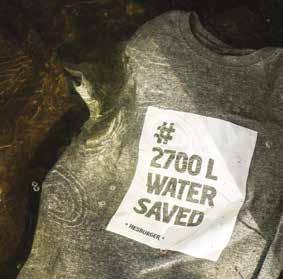

With the long-term goal of expanding their closed-loop method to an industrial scale, the Re-Looping Fashion Initiative is
participant in the production of clothing using the closed-loop method. Luukko emphasizes the importance of fashion and textile companies being at the forefront of sustainable fashion innovations and practices, saying
As a responsible and sustainable company, we have the obligation to develop new, innovative solutions towards a more circular textile industry. Every year millions of tons of textiles are wasted and disposed, instead of utilizing its value as new raw materials. We focus on closing the loop for our workwear customers: designing and developing garments that are easier to recycle, producing them from recycled materials fabrics and finally at the end of their lifecycles, turning them into raw materials to be used in various applications and end products in different industries.
working with organizations from all stages of the fashion industry, including leaders in Nordic fashion, innovation, and sustainability sectors. Project contributors include Finnish textile rental company, Lindström; Seppälä, a Finnish fashion chain; SUEZ, an environmental services and solutions company; Touchpoint, a Finnish provider in sustainably-made workwear; and VTT Technical Research Centre of Finland Ltd, a leading technology and research company in Finland. The project is supported by Tekes—the Finnish Funding Agency for Innovation’s Green Growth program.
Outi Luukko, CEO of Touchpoint, is an advocate for sustainable fashion, and a
The Re-Looping Fashion Initiative is transforming the way people recycle clothing, and in the process demands change from the harmful system of global fashion consumption and production. Change is also required of consumers, who recent studies show buy increasing amounts of cheaply produced, inexpensive clothing, adding to the vicious production cycle of fast fashion. For individuals, sustainability begins by decreasing the purchase of new clothing and by increasing awareness of the environmental impact of the sources one does buy from. Purchasing new clothing from companies that participate in The Re-Looping Fashion Initiative or similar closed-loop processes can be a great start to curating a more ethical and sustainable wardrobe. In making a commitment to sustainable shopping practices, consumers help save water and reduce waste—meaning buyers look good and feel good. Fast fashion? It’s so last season.
Learn more about the Re-Looping Fashion Initiative at reloopingfashion.org
Caroline Parry is the Grants and Giving Coordinator at the National Nordic Museum. She has an MA in art history from the University of Oregon, and a BA in English and Studio Art from Lawrence University.
GREEN IS THE NEW BLACK | 45
“Fashion is the second-most polluting industry worldwide (second only to the oil industry).”
Image courtesy Touchpoint; photographer: Jussi Ratilainen.
50/50 by 2020
Sweden’s cinematic quest for equality
 by Stina Cowan, Educational and Cultural Programs Manager
by Stina Cowan, Educational and Cultural Programs Manager
Sweden is widely recognized for its great filmmakers. Some would argue that Ingmar Bergman is one of the greatest directors of all time; others such as Roy Andersson, Lukas Moodyson, and Ruben Östlund have been film festival and audience favorites for years. What they have in common (besides making noteworthy films) is that they are all men. The global film industry is notoriously male dominated, and historically the only way most women could make a name for themselves in film was in front of the camera.
Sweden’s film industry was no exception. When Anna Serner became CEO of the Swedish Film Institute (SFI) in 2012, she was struck by how few women were involved in filmmaking and production behind the camera. Known for being a gender-equal nation, it would be reasonable to expect that the Swedish film industry would have reached gender equality long before the twenty-first century. Yet Serner found that women held only a small percent of production roles in film, despite SFI working toward bridging the film industry’s gender gap since 2000.
SFI finances about half of all domestic Swedish film projects and is consequently
very powerful in the local film industry. “The institute’s political assignment as a government organization makes it possible to influence the film industry through how we make decisions,” says Serner. And influence they did. In 2016, SFI—under Serner’s leadership—set an ambitious goal: in four years’ time, half of all movies made in Sweden would be directed, written, and produced by women. Thus, the “50/50 by 2020” initiative was born.
The initiative was presented during the 2016 Cannes film festival and consisted of four concrete steps:
Track how many women are involved in all aspects of filmmaking
Update the database nordicwomeninfilm.com (founded in 2015) with these numbers
Produce an annual gender equality report to spread knowledge about the inequality
Focus funding to better enable women to make high-budget films
50/50 by 2020 is not without controversy. Some male directors have felt that they have lost support for their projects. Some female directors, especially young women, have taken issue with being labelled “female directors” when they prefer to be known as simply “directors.” Serner, however, maintains that it is her generation’s responsibility to ensure equality in the industry. “There is a great deal of longterm work left that will take generations to complete. Our generation has a responsibility to leave not only a climatesustainable world to the next generation but also one that values the equal value of human beings.” As a result of the initiative, great filmmakers such as Niki Lindroth von Bahr, Amanda Kernell, Gabriela Pichler, and Rojda Sekersöz have received funding that resulted in award-winning films, enriching a global audience.
The 50/50 by 2020 initiative has permeated the international film and film festival world. In January 2019, the Berlin Film Festival followed Cannes and Venice in
signing an equality pledge. This document committed their industries to equal gender representations on screen and in management, as well as promised transparency in their selection process. The movement TRANSform Hollywood has created a guidebook under the name 5050by2020, which urges Hollywood to change the way trans* people are portrayed in media and culture. It is safe to say that the initiative has reached far and wide. Now it is a global movement, and even notoriously sexist Hollywood is starting to take action.
But in the year 2021, has the parity goal been met? In Sweden, the answer is partly yes: male and female directors make approximately the same number of films, but male directors still make most of the big budget movies. Elsewhere, the movement continues to make strides. Serner notes that more female directed and produced films are included in major international film festivals since the initiative was formed. In addition, the Gothenburg Film Festival pledged to and then ensured that half of the films featured in their 2020 festival were directed by women. Serner says she is proud of the work that has been done by her institution, and is moved when she meets with people from all over the world who have embraced the equality goal. She concludes, “gender equality makes the work more relevant for everyone.”
The work to ensure gender equality in film is far from complete; however, the strides made by the 50/50 by 2020 initiative are steps that put the industry well on its way to a more equitable future.
Stina Cowan is the Educational and Cultural Programs Manager for the Nation Nordic Museum. She loves cinema and mixes work and pleasure when she manages the annual Nordic Lights Film Festival and Sámi Film Festival, as well as the monthly Soup & Cinema program for the Museum.
46 | NORDIC KULTUR
Equality
Photo by Mason Kimbarovsky on Unsplash.


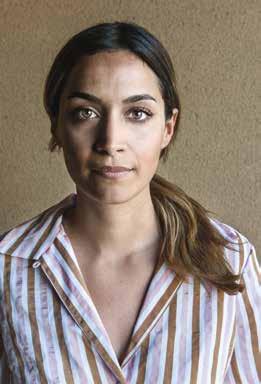


50/50 BY 2020 | 47
CLOCKWISE FROM TOP LEFT Amanda Kernell, Anna Serner, Gabriela Pichler, and Rojda Sekerös
Photo by Carla Orrego Veliz.
Photo by Marie-Therese Karlberg.
Photo by Tobias Henriksson.
Photo by Johan Bergmark.
A MARRIAGE OF NEW AND OLD Nordic wedding traditions
 by Kate Dugdale, Education and Interpretation Coordinator
by Kate Dugdale, Education and Interpretation Coordinator
Modern weddings throughout the Nordic countries today would in many ways look very familiar to an American audience. That’s not surprising: the American wedding industry has a global influence on trends, and American wedding customs are widely represented in film and television. Despite the growing influence of Americanized wedding practices, however, many solidly Nordic wedding traditions remain a large part of pan-Nordic wedding celebrations. From the wedding outfits and ceremony, to the cake and dancing, many Nordic customs endure.
One instantly recognizable Nordic accessory is a traditional bridal wedding crown. In Norway, traditional bridal headdresses were originally made of textiles. The metal adornments played an important spiritual and monetary role particularly in the eighteenth century.
Precious metals in bridal jewelry and headwear were important because they were a form of transportable wealth. Including metal in wedding wardrobes also had spiritual significance, due to metaphysical entities such as the huldrefolk. These otherworldly creatures were said to
live inside mountains and steal both adults and babies when they were vulnerable; weddings were one such vulnerable time.
According to artist Lori Talcott, weddings were a time of transformation for the bride and groom—they were transitioning from one state of being to another, from the status of an unmarried person to that of a married person. This moment of transformation called for items to protect the marrying couple, such as metal. The headdresses fit into that folklore-imbued daily rural life, where “every season and each activity was mediated and punctuated by ritual and magic—reciprocal actions that ensured the fertility of the fields, livestock, and humans, food production, and lifecycles.” Depending on the location in Norway, the bride might wear a hat decorated with beads or a metal crown with hanging decorations, sometimes in the shape of crosses. These crowns or headdresses often feature metal lace.
The custom of wearing bridal headdresses made from textiles and metals lives on today, thanks to a surge of interest in traditional practices. In Tinn, Norway, the fashion of wearing a bridal hat almost died out. The last known instance of a bride
48 | NORDIC KULTUR
Heritage
wearing a Tinn tat—a distinctive, top hatstyle head covering—was in 1853. But in the 1990s, Talcott began working with KariAnne Pedersen, Curator of Costumes and Textiles at the Norwegian Folk Museum, to resurrect this ancient accessory. In 1994, Talcott and Pedersen’s new-construction Tinn hat made its debut in an exhibition at the Museum. Six years later, it was worn by a bride for her wedding at Volun farm, in Tinn, Telemark. After a 147-year slumber, the Tinn hat tradition was wide awake.
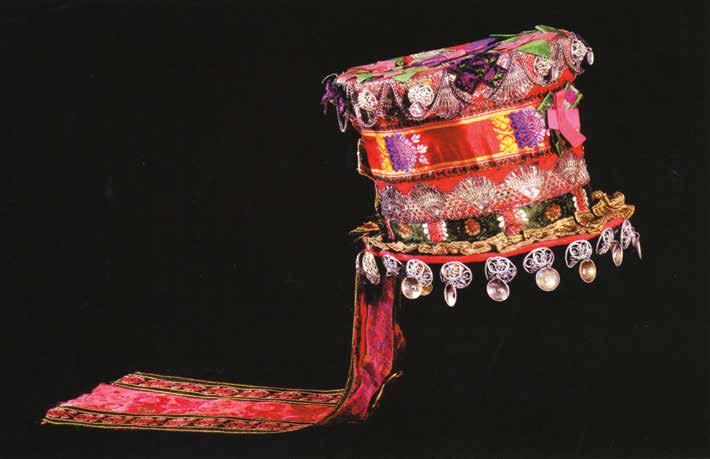
In Sápmi, brides might opt to wear the traditional costume of the Sámi people— a gákti or kolt—on their wedding day. Gáktis are made of leather, sinew, wool, and occasionally silk and velvet; the specific designs vary from community to community. Interestingly, one element of the gákti is a coded message. On some gáktis in the north Sámi area, the shape of the belt buttons indicates marital status— square buttons mean that the person is married, while unmarried individuals wear round buttons.
In Sweden, custom dictates that the bride and groom walk down the aisle together. This tradition is part of the established customs of the Church of
Sweden, and symbolizes the marrying couple entering their new life together. However, this tradition has been impacted by the growing popularity of American wedding practices. When Crown Princess Victoria married Daniel Westling in 2010, she opted to blend the two customs: Her Royal Highness walked down part of the aisle with her father, King Carl XVI, where she was met by her soon-to-be husband to walk the rest of the way together.
Much like in the United States, dancing is a big part of a wedding party in the Nordic countries. In Denmark, the newlyweds’ first dance is a bridal waltz, which custom demands should takeplace before midnight. During the waltz, the guests form a circle around the couple, clapping along to the music and slowly closing ranks. This ends when the couple has no space left to dance in. A famous example of this tradition was included in the 2004 wedding of Danish Prince Frederik II and his Australian bride, Princess Mary.
Waltzes play a role in traditional Finnish weddings, too. Like Danish weddings, the first dance is often a waltz—but the end of the wedding celebration might include a “weaning-waltz.” In a weaning waltz, all
A MARRIAGE OF NEW AND OLD | 49
Bridal hat, Tinn, Telemark.
FACING PAGE A kransakake made by Seattle’s designer Scandinavian bakery, Byen Bakeri.
Photo courtesy Norwegian Folk Museum, Oslo.
the female guests waltz with the bride one by one, while the male guests take turns dancing with the groom. At the end of the dance, the bride and groom are reunited. Despite their regional differences, one similarity throughout many Nordic weddings is the wedding cake. Known as kransekake in Norway and Denmark and kransakaka in Iceland, this tall “wreath” cake is made by layering individual rings to form the tall conical structure, which is then held together by royal icing. Traditionally, these cakes have at least eighteen layers. In addition to being delicious, those layers provide a bit of fun for the wedding guests. One tradition is to have the newlyweds lift the cake by the top layer: the number of rings that remain attached to the top layer is supposed to predict how many children the couple will have.
Although American customs may be
influencing Nordic weddings, Nordic weddings are not without their own global influence. The word “honeymoon” has its roots in the ancient Scandinavian practice of drinking mead during the first month of marriage. Drinking mead together for thirty days has two different functions. Mead (or fermented honey) was symbolic for celebrating the sweetest part of marriage. More practically, another reason for drinking mead every night was that it improved the likelihood of a swift conception. Despite American influence, many established traditions are still beloved and thriving parts of Nordic wedding ceremonies and celebrations. And whether strictly traditional or more modern blend, there is one thing in common among Nordic and American weddings: they are usually a party.

Genealogy Programs Flourish at Museum
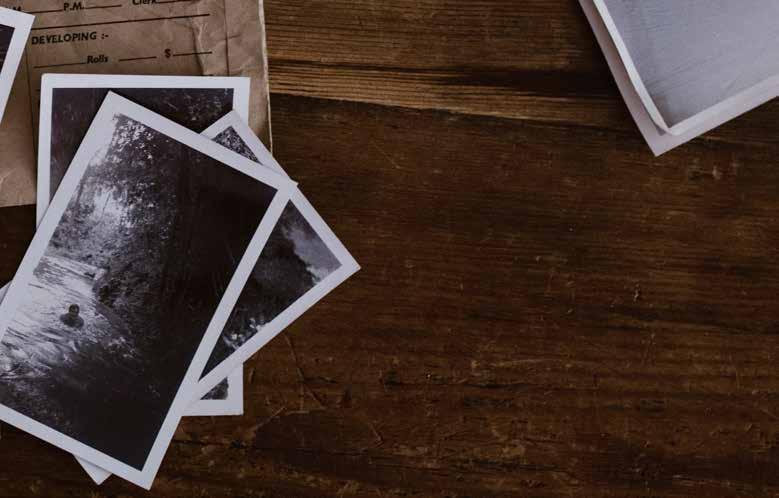
The Museum’s popular Nordic Genealogy Program proved a virtual hit throughout 2020. These forty-five-minute, one-onone consultations with Kathi McGinnes of the Seattle Genealogical Society frequently sold out for months in advance of appointment times. The Museum will continue to offer virtual genealogy consultations and other online resources this year.
The first Virtual Nordic Genealogy Conference in September 2020 attracted attendees from twenty-four states and three Canadian provinces. One of the most popular sessions—“Sámi Identity and Genealogy: What Does it Mean to be Sámi?”—was taught by Pacific Lutheran University Professor of Nordic Studies Troy Storfjell, who identifies as Sámi. Storfjell helped found the interdisciplinary Native American and Indigenous Studies Program at PLU. This session is available to view for free on the Museum’s YouTube channel.
The Conference can be viewed online through September 2021, with Museum Members enjoying a significant savings. Interested parties can learn more and register at nordicmuseum.org/genealogyconference.
50 | NORDIC KULTUR
An article on the traditional Tinn hat by Lori Talbott can be found on the Museum’s blog at nordicmuseum.org/blog/tinnhat
Kate Dugdale is the Education and Interpretation Coordinator from the National Nordic Museum. Outside of the Museum, she enjoys making art and researching women’s history in the United States.
Photo by Holger Motzkau.
Photo by Annie Spratt on Unsplash.
Wedding of Victoria, Crown Princess of Sweden, and Daniel Westling.
Crayfish Craze
How to throw an authentic Swedish kräftskiva
PICTURE AUGUST IN SWEDEN and everywhere you look will be crayfish— crayfish garlands, people wearing crayfish hats and bibs, and the most glorious sight of all, heaping platters of freshly boiled crayfish waiting to be devoured. Warm up your vocal chords, don your bib, and grab a shot of akvavit, because it’s kräftskiva season!
Kräftskiva, Sweden’s famous annual seafood celebration, literally means “crayfish party,” and traditionally takes place during the month of August. This longtime Swedish tradition sees friends and family gathering outside to eat massive
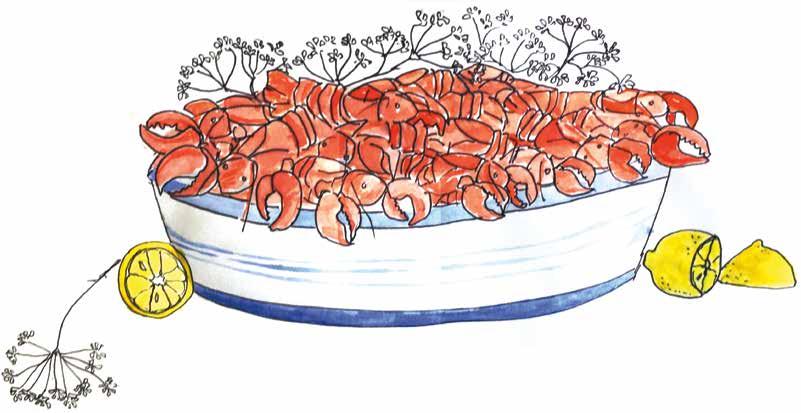 by Caroline Parry, Grants and Giving Coordinator
by Caroline Parry, Grants and Giving Coordinator
platters of crayfish and sing drinking songs late into the night.
The history of the Swedish crayfish party dates back as early as the sixteenth century, where it originated as a special occasion reserved for aristocracy. In the late nineteenth century, crayfish became rare in Sweden due to increased exports of the shellfish. The Swedish government imposed laws limiting crayfish catching to just two months a year—August and September—thus launching a country wide celebration of crayfish season. By the twentieth century, crayfish had become a
national delicacy, with all levels of society participating in a monthly celebration of the special shellfish.
The name “kräftskiva” was coined in the 1930s, and the term was likely derived from the nineteenth century bourgeois crayfish ritual of kräftsupa, which involved the consumption of crayfish and alcoholic drinks.
While the restrictions on fishing and selling crayfish were lifted in Sweden in 1994 (making crayfish available beyond September), the tradition of celebrating crayfish season in August remains.
CRAYFISH CRAZE | 51
Heritage
Throw Your Own Crayfish Party
Not able to make it to Sweden this August? Don’t worry—Swedish-born chef Malin Jonsson of Borgstrom Catering shares some insider tips and recipes below to ensure your crayfish gathering is a success.
The Supplies
It wouldn’t be a proper kräftskiva without crayfish-adorned decorations. Colorful paper hats, bibs, and paper lanterns— all featuring images of the crustacean of honor—are a must-have for any crayfish party. These party supplies are readily available in Sweden in any grocery store: in the United States revelers can find printable hat templates online to make their decorations or seek out IKEA’s crayfish party pack for specially-made decorations.
The Menu
Of course, it’s not a crayfish party without crayfish on the menu. But what else should be served alongside the gastro-guest of honor? “(Y)ou can serve a chanterelle quiche with a side salad, baguette bread, and a cheese platter as a starter or as a main,” says Chef Malin. “It really doesn’t matter in which order you eat the two dishes. Some guests prefer one over the other. A toast with a large heap of butter-sautéed chanterelles is also a classic starter. Dessert is usually some kind of apple or berry crisp or crumble with vanilla custard sauce.”
Hot tip for guests who prefer meat on the menu—during her time in Seattle, Chef Malin has added doublemarinated pork tenderloin with a side of French potato salad to her kräftskiva menu. This ensures the meat-lovers at your table are happy and provides plenty of options for everyone.
The Crayfish
Typically, crayfish are boiled in water mixed with salt and sugar, which is often spiked with ale and crown dill. The crayfish turn from black to red when cooked. They are served piled high on large platters and eaten cold.
The Sides
Västerbotten Pai (Swedish Cheese Pie), chanterelle quiche, salad, boiled potatoes, and bread are all popular side dishes.
The Drinks
Cold beer and akvavit (don’t forget the shot glasses!) are a staple at any crayfish party. Wine, while not unheard of, is not traditionally part of the menu, and Chef Malin voices a strong preference against it. She also suggests plenty of soda and water for the designated drivers and younger guests.
The Songs

Almost as important as the crayfish themselves, drinking songs are an essential part of any crayfish celebration. Oftentimes guests are provided with a printed songbook containing the lyrics to classic Swedish tunes. As the evening progresses, different guests will take turns leading the group in song; each song followed by a toast, typically with cold beer or aquavit.
Traditional Swedish Drinking Song
Helan går, courtesy of Swedish Women’s Educational Association, Seattle. (This is the most well-known nubbesong and is even heard in Swedish preschools!)
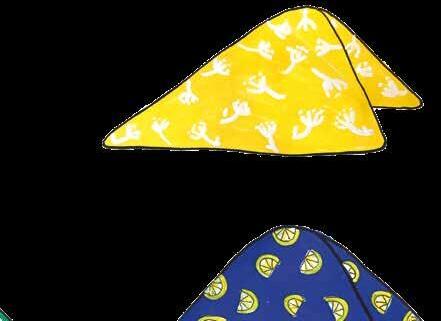
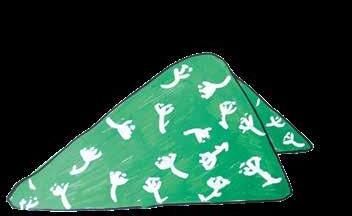

SWEDISH:
Helan går
Sjung hopp fadderallan lallan lej
Helan går
Sjung hopp fadderallan lej
För hon som inte helan tar
Hon heller inte halvan får

Helan går (drink)
Sjung hopp fadderallan lej
ENGLISH:
Here’s the first
Sing “hup fol-de-rol la la la la”
Here’s the first
Sing “hup fol-de-rol la la”
He who doesn’t drink the first
Shall never, ever quench his thirst (drink)
Sing “hup fol-de-rol la la”
52 | NORDIC KULTUR
52 | NORDIC KULTUR
Illustrations by Caroline Parry.
Crayfish Brine
courtesy of Chef Malin Jonsson
For approximately 50–70 crayfish
2.6 gallons [10 liters] water
1¾ cups [350 grams] kosher salt
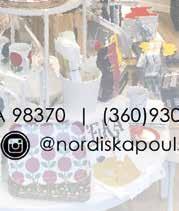
2 tablespoons [30 grams] sugar
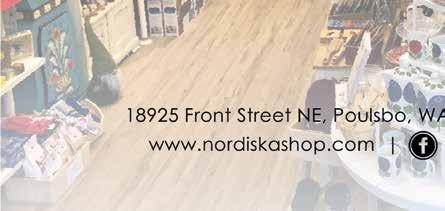

15 lbs crayfish
Combine the water, salt, and sugar in a pot over medium-high heat and bring to a boil. Add a bunch of pickling dill, then add crayfish and simmer until they turn bright orange/ red (approximately twenty minutes.) Let the crayfish cool in the brine.
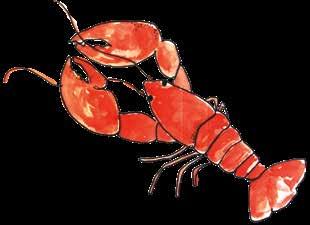
Refrigerate to keep crayfish cool and serve within two days, garnished with additional dill crowns.
Fun Terms
Kräftskiva—Crayfish party
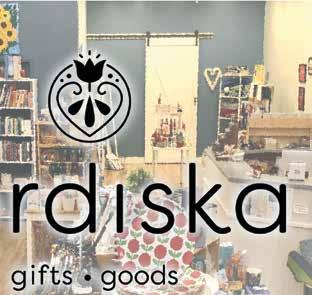
Snapsvisor—Drinking songs
Lykta—Lantern
Servetter—Napkins
Kräftklo—Crayfish claw
Nubbe—Schnapps
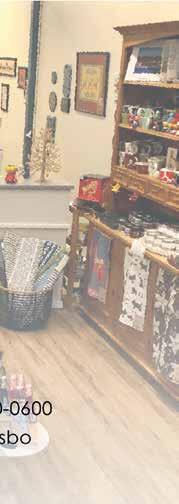

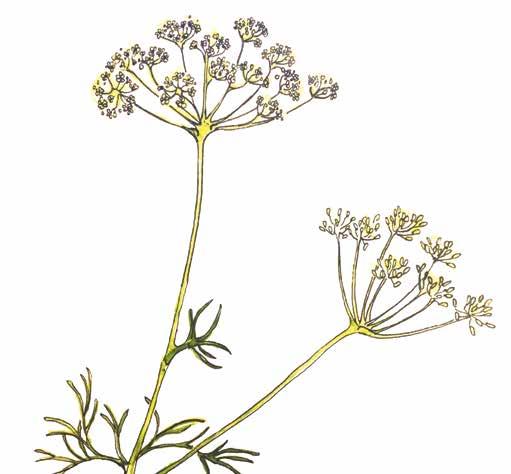
BIG ICE, BIG LOSS | 53 Visit our expanded online store CRAYFISH CRAZE | 53
Photo by Kelly Sikkema on Unsplash.
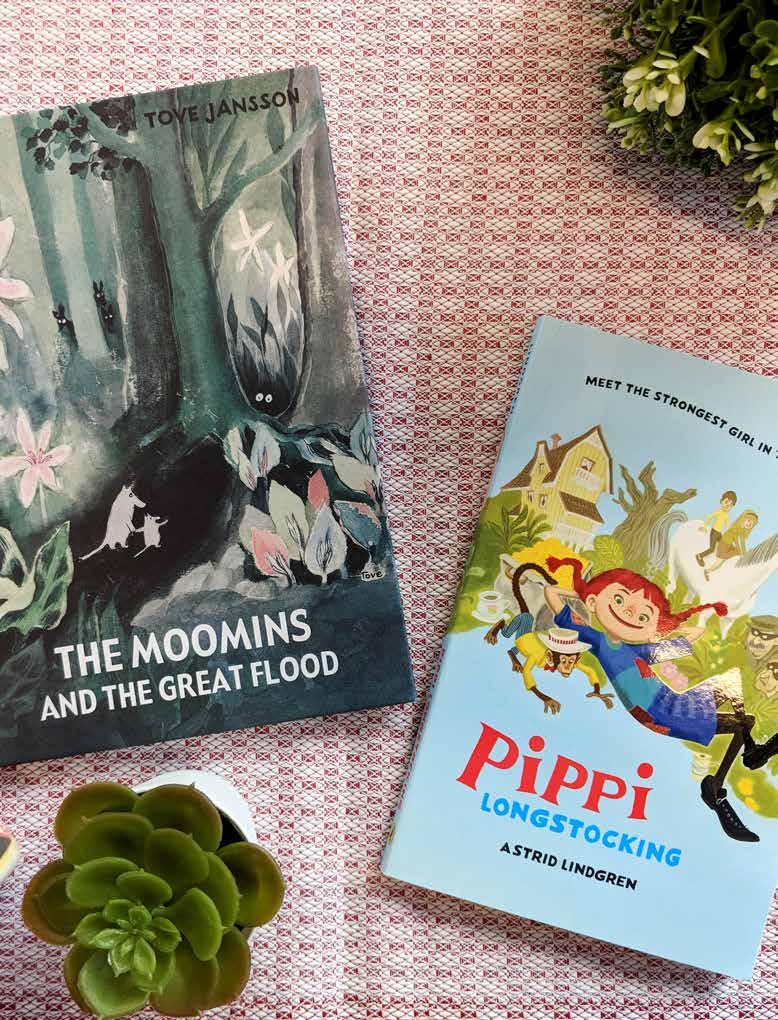
Heritage
Happy 75th Birthday, Pippi and Moomins!
by Ann-Charlotte Gavel Adams, PhD Professor Emerita, Barbro Osher Endowed Chair of Swedish Studies, University of Washington
Perhaps one of the few good things about the year 2020 is the opportunity to celebrate the seventy-fifth anniversary of the publications of Astrid Lindgren’s Pippi Longstocking (Pippi Långstrump) and Tove Jansson’s The Moomins and the Great Flood (Småtrollen och den stora översvämningen). The anniversary was more than just a commemoration of a couple of beloved figures in Nordic children’s literature. With Pippi Longstocking and the Moomins, the children of the world got—at long last—a literature of their own: books without moral subtext or instruction.
Already in 1900, Swedish feminist and educator Ellen Key predicted that the twentieth century would become “The Century of the Child” (Barnets Århundrade) with her book by the same title. She was right, but it was to take another forty-five years until Nordic children could enjoy fun books written with their needs in mind, absent of moral pointers. Up until the mid-nineteenth century, only children of the upper classes and the nobility learned to read, and they were fed books of manners and morals and biblical stories. When public schooling became mandatory in the mid-nineteenth century, all children had to learn basic skills like reading and writing and doing arithmetic. This created a whole new readership of children from different backgrounds and with diverse interests. The schoolteachers, who wrote these early books for children, focused on proud nationalistic themes, what it meant to be Nordic, the flags, flora, and fauna. Children were to be seen but not heard.
Historically, up until 1945, books for children were still written by adults for the benefit of the adult society: the actual needs and interests of the children themselves were not taken into account. That changed after World War II, when new educational theories from England and the US reached Sweden. Children now became viewed as individuals, separate human beings, to be respected. The child’s need to play and have fun became recognized. Two Nordic authors in particular, Astrid Lindgren and Tove Jansson, stepped up to usher in a wave of literature just for kids.
Pippi Longstocking
Astrid Lindgren (1907–2002) made it quite clear from the beginning that her target audience was children. “I don’t want to
write for adults. I want to write for readers who can work miracles,” she said. Her book, Pippi Longstocking, was published in November 1945, and was an immediate success. One newspaper critic called it “a safety valve” (en säkerhetsventil) for children who had felt powerless and whose psychological needs had been suppressed. Another critic called Pippi a combination of Huckleberry Finn and Superman. Not everyone embraced Pippi’s verve—in particular, John Landquist, an outspoken professor of pedagogics and psychology, grumbled and called the book “distasteful and immoral,” predicting Pippi would be quickly forgotten. He could not have been more wrong.
In Pippi Longstocking, children who had grown up feeling repressed and powerless in their war-torn world suddenly had a pint-sized hero who modeled independence and hope. In a letter to her publisher in 1944, Lindgren recognized a certain indebtedness to British polymath and Nobel laureate Bertrand Russel. It was Russel’s book Education and the Good Life (1926), which Lindgren had read in Swedish translation Uppfostran för livet (1933), that described the will to have power as the foremost instinct in human beings. Even children, Russel inferred, had an instinct to want a sense of control. Children were actually suffering from their own lack of power in comparison to older friends and adults. Children needed to indulge in fantasies of having power. In Pippi, Lindgren created a character who had that power, who was totally independent of adults, and did whatever she felt like. This is part of Pippi’s magic.
Lindgren credits her daughter Karin with coming up with the name “Pippi Långstrump.” Karin was sick in bed and asked her mother to tell her a story about a child named Pippi Långstrump—and a wild name required a wild character, Lindgren thought. Pippi is outlandish, and her hilarious ideas and silly antics go against all the proper manners and behaviors taught in earlier children’s books. Reading Pippi Longstocking was a revelation to children of the time, and to this day continue to delight them. Pippi makes children laugh out loud when they read that she pours water on the kitchen floor and ties brushes to her feet so that she can skate while mopping. She makes children giggle when she plays tag with the policemen and chases them up on the roof when they try to take her to an orphanage. Pippi has no parents to restrict her boundaries. She has total freedom and the
HAPPY 75TH BIRTHDAY, PIPPI AND MOOMINS! | 55
“Oh yes, time flies and before you know it, you’re old.”
—Pippi, in Pippi Longstocking Goes Abroad
power to do whatever she wants, and thereby she empowers her young audience to imagine what is or could be possible. Authority figures like policemen and social workers are mercilessly ridiculed. Pippi’s behavior was quite shocking for many contemporary Swedish educators and critics, but Lindgren’s young readers felt a sense of liberation that they had never experienced before.
The “strongest girl in the world,” as Pippi calls herself, is certainly not without morals, as some early critics feared. A guiding theme in the Pippi stories is that if you are very strong, you also need to be very kind. This message resonated with Pippi’s first audience in 1945, just as it does today. Her legacy lives on.

The Moomins
Tove Jansson (1914–2001), the “Mama of the Moomins,” started out as a painter and graphic artist. While she composed some stories as teenager, it was not until after World War II that she started writing the Moomin books. The tales grew out of that dark period in history when World War II left the western world in ruins. During the war, Tove Jansson worked as a political cartoonist, so she was very familiar with the despair and hopelessness of the times. Against this backdrop, Jansson dreamed of a peaceful world and happy society. She brought this world to life in the Moomin books. And though the Moomins’ safe and idyllic world is sometimes threatened by floods, tornados, and comets, in the end, tranquility is restored. A return to happiness and normalcy deserves, of course, to be celebrated with a big party.
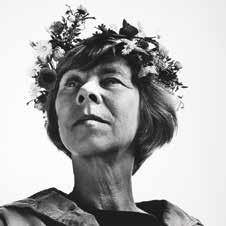
The Moomins were born long before Jansson wrote The Moomins and the Great Flood in 1945. The first Moomin figure was drawn on a wall of the outhouse on the Jansson family’s Baltic summer island in a graffiti dialogue between Tove and her brother, Lars. The name “Moomin troll” was coined by Jansson’s maternal uncle Einar Hammarsten. Jansson lived with the Hammarstens while attending art college. She would often get up at night and raid the pantry. Uncle Einar warned young Tove that the “moo-oomoomin trolls” lived in the pantry and behind the stove in the kitchen. These pantry trolls looked like ghosts with eyes like Sun Maid raisins and they would rub their cold noses on your legs and blow cold air down your neck if you got up in the middle of the night to get a snack from the pantry. Over time, the Moomin trolls grew plumper and cuter until they came to look like little white hippopotamuses—quite different from the original pantry ghosts or the traditional Nordic trolls, which were big and scary if they were Norwegian (Asbjørnsen and Moe), or big, clumsy, and stupid if they were Swedish (Bauer).
The first Moomin book The Moomins and the Great Flood
(Småtrollen och den stora översvämningen) was published just after the end of World War II. It did not receive much attention at the time, and it was not translated to English until 2005. Not until the next two Moomin books—Comet in Moominland (Kometjakten) in 1946 and Finn Family Moomintroll (Trollkarlens hatt) in 1948—did Moomin fever catch on. Here children were introduced to a world of lovable and distinct characters, each with their own flaws and motivations. Jansson said that she wrote the Moomin books for the child in herself, the one that craves adventure and excitement but who at the same time feels powerless and rejected. Like Lindgren, Jansson understood that children can feel powerless, and that they need adventure and excitement; she gave children that sense of power, adventure, and excitement with her Moomins.
What is the magic of the Moomins? It is the deep and complex feelings that Jansson personifies in the different Moominvalley inhabitants—deep feelings that children recognize and can relate to. Children can be scared like the Filliyonk, who never feels safe and is sure that something bad is going to happen. Or they can be intimidated like Ninni, who was so impacted by her insensitive, sarcastic aunt who raised her that she became invisible. Children can be insecure like Sniff, who likes shiny things and would like to get rich so he can afford all the things he does not have. They can also be super cool like Snufkin, or outspoken and shameless like Little My, or vain and romantic like the Snork Maiden. Or innocent and trusting like Moomintroll.
In one story, sweet Moomintroll finds the most beautiful golden miniature dragon which he falls in love with and wants to keep all to himself. Moomintroll wants the dragon to love him and only him—but instead the dragon loves only Snufkin, and hisses at and bites Moomintroll. What do you do when you want somebody to love you, and they do not? Moomintroll’s story with the dragon communicates with kids on a level they can understand—it becomes a lesson in how to deal with unrequited love and with the pain and feelings of rejection that stem from it.
Though the Moomin series is usually considered as books for children, the stories appeal to adults as well. Jansson’s tales are really allegories, and they are often so sophisticated that they can better be understood on a deeper level by grown-ups. The Moomin figures are not only fictional characters—they are each a personification of human traits and behavior patterns that we recognize in ourselves, in our friends and family, and acquaintances. One popular feature on the Moomin website—“Which Moomin Character Are You?”—tells you which Moomin character you most resemble based on your answers to the personality quiz.
56 | NORDIC KULTUR
Courtesy Astrid Lindgren Company.
Creative Commons / Public domain
Like Lindgren’s Pippi Longstocking, the everyday experiences of the Moomins become an accessible way for children (and adults) to consider big feelings and real-life experiences, without pushing a moral. Children can relate and comprehend at their own pace, wrestling with adult situations but in the safe and secure fantasy lands conjured up by these two beloved authors. Pippi and the Moomin trolls, these iconic figures in Nordic children’s literature, may be seventy-five years old today, but they are as alive and kicking today as they were in 1945. Happy birthday, Pippi and Moomins! You may live long but you will never grow old.

Learn more about Pippi Longstocking at astridlindgren.com Learn more about Moomintrolls (and take the character quiz) at moomin.com
Tuulikki


Julefest 2021
November 20–21 A Nordic Christmas celebration nordicmuseum.org/julefest
HAPPY 75TH BIRTHDAY, PIPPI AND MOOMINS! | 57
Ann-Charlotte Gavel Adams is Professor Emerita of Nordic Literature with research interests in Swedish author August Strindberg, Nordic women writers, and Nordic children’s literature.
Courtesy Astrid Lindgren Company.
Creative
/ Public
Photo by Joanna Kosinska on Unsplash.
Commons
domain
TOP TO BOTTOM Astrid Lindgren with Pippi and Bullerbyn in German.
Pietilä, Tove Jansson, and Jansson’s mother Signe at Klovharu, the island in the Porvoo archipelago where the Janssons had a summerhouse, 1958.
FACING PAGE
TOP TO BOTTOM Astrid Lindgren and her daughter, Karin, 1948. Jansson in 1967.
Judith H. Dern fell in love with Denmark on her first trip to Europe as a college sophomore. After graduation, she returned to Scandinavia for a year to study textiles in Finland and further explore Nordic lands. She has happily returned almost every year since then. Eventually trading textiles for writing, she is the author of four cookbooks, including her most recent title: The Food and Drink of Seattle—From Wild Salmon to Craft Beer. Wandering westward from her East Coast origins, she has lived in San Francisco and is now in Seattle but has constant daydreams of returning to Copenhagen for further culinary adventures.
Danish Delight:
Beer Soup with Whipped Cream Øllebrød med flodeskum
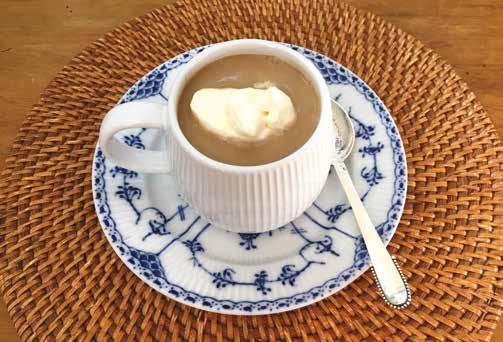 by Judith H. Dern, Author and Cook
by Judith H. Dern, Author and Cook
RYE BREAD AND BEER ARE DANISH STAPLES, beloved by both Danes and Danish-Americans. Combined with rich cream in this easy-to-make soup, the three ingredients spiced with cinnamon and lemon create a smooth surprise tasting like liquid gingerbread. Often tagged as one of Denmark’s oldest recipes,
SERVES 6
INGREDIENTS
3 slices dark rye or pumpernickel bread
4 cups (32 fluid ounces/1 litre) dark or IPA beer
1⁄ 3 cup white sugar, or amount to taste
1 tablespoon vanilla sugar
1⁄ 2 lemon, cut into three slices
2 cinnamon sticks
2 egg yolks
1 cup (8 fluid ounces/250 ml) half-and-half or light cream
11⁄ 2 cups (12 fluid ounces/350 ml) heavy whipping cream
salt to taste
DIRECTIONS
some of a certain generation recall their parents serving it “to keep the children happy and calm.” Hearty and simple, served warm or chilled at breakfast or for dessert, this unusual soup expands the boundaries of Danish deliciousness.
Recipe adapted from Danish Food & Cooking by Judith H. Dern
I Toast the bread slices until dry but not overly browned, and then crumble coarse pieces (including the crusts) into a saucepan. Pour the beer over the breadcrumbs and let the mixture soak for 15 minutes, stirring once or twice.
II Stir the white sugar, vanilla sugar, and lemon slices into the bread and beer mixture. Drop in the cinnamon sticks. Simmer the mixture over medium heat—don’t let it boil—stirring occasionally, for about 15 minutes, until it’s heated through. Remove from the heat, and then use a fork to pull out and discard the lemon wedges and cinnamon sticks from the mixture.
III In a good-sized mixing bowl, beat the egg yolks together with the half-andhalf and 1 cup of the heavy cream to make a smooth mixture. Stir a goodsized spoonful of the hot beer mixture into the cream mixture to temper the eggs. Using a whisk, slowly blend in the remainder of the beer mixture. The mixture may be served warm, or chilled and served cold.
IV Before serving, pour the remaining 1⁄ 2 cup of heavy cream into a bowl and beat until stiff peaks form. Swirl a spoonful of whipped cream into each bowl and enjoy!
COOK’S TIP: If the beer used makes the mixture taste too hoppy or tangy, adjust by adding a tablespoon or so of white sugar.
Recipe 58 | NORDIC KULTUR
Modern Design
Classic Ambiance
Historic Events
Rent the National Nordic Mueum
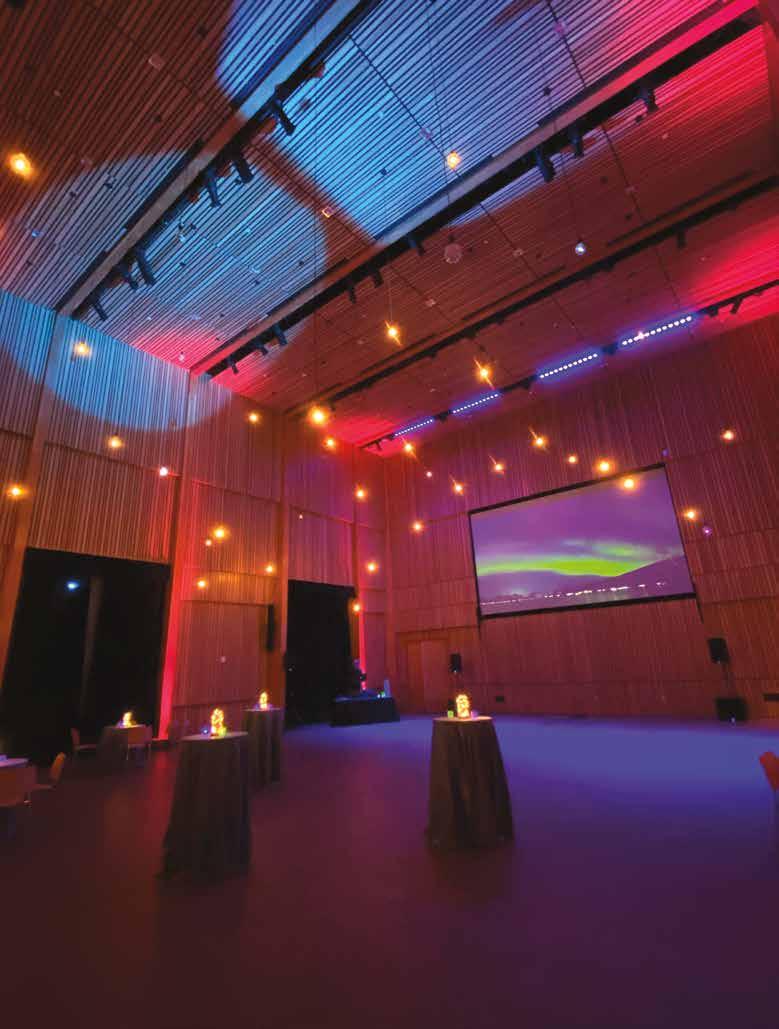
Meetings
Conferences
Retreats
Holiday Parties
Weddings
nordicmuseum.org/rentals
Thank you to our sponsors






































 etalusnoClareneGdnalniF soLselegnA
Keta Enterprises
Nysether Family Foundation
The Robert Lehman Foundation
etalusnoClareneGdnalniF soLselegnA
Keta Enterprises
Nysether Family Foundation
The Robert Lehman Foundation
And additional support from Thank you to our media sponsors With support from the Nordic Embassies
Krueger Sheet Metal


2655 NW Market St Seattle, WA 98107 NON-PROFIT ORGANIZATION U.S. POSTAGE PAID SEATTLE, WA PERMIT NO. 13008

























 by Leslie Anne Anderson, Director of Collections, Exhibitions, and Programs
by Leslie Anne Anderson, Director of Collections, Exhibitions, and Programs












































 by Rosemary Jones, Marketing Director
by Rosemary Jones, Marketing Director
















 by Becky Forsberg, Guest Services Manager
by Becky Forsberg, Guest Services Manager








 by Erik Pihl, Director of Development
by Erik Pihl, Director of Development








 by Stina Cowan, Educational and Cultural Programs Manager
by Stina Cowan, Educational and Cultural Programs Manager





 by Kate Dugdale, Education and Interpretation Coordinator
by Kate Dugdale, Education and Interpretation Coordinator



 by Caroline Parry, Grants and Giving Coordinator
by Caroline Parry, Grants and Giving Coordinator



















 by Judith H. Dern, Author and Cook
by Judith H. Dern, Author and Cook


















